Understanding and Using English Grammar - 5th Edition



Understanding and Using English Grammar - 5th Edition
1. PRESENT AND PAST; SIMPLE AND PROGRESSIVE

What you will learn:
- Simple Present is for habits, facts, and general truths, while Present Progressive is for actions happening now or temporary situations.
- Negatives & Questions: Simple present uses do/does, while present progressive uses am/is/are + verb-ing.
- Stative Verbs describe states (thoughts, emotions, senses, possession) and are not usually used in progressive form.
- Simple Past is for completed actions, while Past Progressive is for ongoing past actions that were interrupted.
- Was/Were Going to expresses unfulfilled intentions (plans that did not happen).
- Time expressions (yesterday, last week, etc.) help differentiate past actions.
- Irregular past verbs need to be memorized (e.g., go → went, see → saw).
1-1. Simple Present and Present Progressive

- Simple Present → Used for habits, routines, facts, and general truths.
- She works every day. (Habit)
- Water boils at 100°C. (Fact)
- Present Progressive → Used for actions happening right now or temporary situations.
- She is working on a project now. (Happening now)
- They are staying at a hotel this week. (Temporary action)
- Key Difference:
- I write emails every day. (Routine – Simple Present)
- I am writing an email now. (Happening now – Present Progressive)
1-2. Simple Present and Present Progressive: Affirmative, Negative, Question Forms

Simple Present Forms:
- Affirmative (+): He eats breakfast.
- Negative (-): He does not eat breakfast.
- Question (?): Does he eat breakfast?
Present Progressive Forms:
- Affirmative (+): She is eating now.
- Negative (-): She is not eating now.
- Question (?): Is she eating now?
✅ Remember:
- Simple present uses do/does for negatives and questions.
- Present progressive uses be (am/is/are) + verb-ing.
1-3. Verbs not Usually used in the Progressive (Stative Verbs)


- Some verbs do not normally appear in the progressive form because they describe states rather than actions.
- Common Stative Verbs:
- Thoughts: know, believe, understand, think (opinion)
- Emotions: love, hate, like, want, prefer
- Senses: see, hear, smell, taste
- Possession & Existence: have, own, belong, exist
❌ She is liking coffee. (Incorrect)
✅ She likes coffee. (Correct)
1-4. Simple Past Tense

- Used for completed actions in the past.
- Often used with time expressions like yesterday, last week, two days ago, in 2010, etc.
- I watched a movie last night.
- She visited her grandma yesterday.
✅ Regular Verbs: add -ed → play → played, walk → walked
✅ Irregular Verbs: change form → go → went, eat → ate, buy → bought
1-5. Simple Past vs Past Progressive


- Simple Past → A completed action in the past.
- She called me last night.
- Past Progressive → An action that was ongoing in the past (often interrupted by another action).
- She was calling me when I arrived.
📌 Key Difference:
- I watched TV last night. (Simple past – completed action)
- I was watching TV when she called. (Past progressive – interrupted action)
1-6. Unfulfilled Intentions: Was/Were Going to

- Used to describe plans or intentions that did not happen.
- I was going to call you, but I forgot.
- She was going to travel, but she got sick.
✅ Often used when explaining why something did not happen.
2. PERFECT AND PERFECT PROGRESSIVE TENSES

This section covers perfect and perfect progressive tenses, explaining their forms, usage, and common patterns in spoken and written English.
What you will learn:
- Regular verbs form the past with -ed, while irregular verbs have unique forms.
- Present Perfect is used for unfinished actions, while Simple Past is for completed past actions.
- “Since” refers to a starting point; “For” refers to a duration of time.
- Present Perfect Progressive emphasizes ongoing actions with duration.
- Past Perfect describes actions completed before another past action.
- Past Perfect Progressive focuses on continuous actions before a past event.
- Contractions like I’ve, he’s, we’d are common in spoken English.
2-1. Regular and Irregular Verbs

- Regular verbs form the past tense and past participle by adding -ed.
- play → played, walk → walked
- Irregular verbs have unique past and past participle forms that must be memorized.
- go → went → gone, see → saw → seen
2-2. Irregular Verb List



- English has many irregular verbs that do not follow the -ed pattern.
- Some common irregular verbs:
- begin → began → begun
- choose → chose → chosen
- write → wrote → written
- Memorizing these forms is essential for perfect tenses.
2-3. Present Perfect: Since and For

- Used for actions that started in the past and continue to the present.
- I have lived here since 2010. (specific starting point)
- She has worked there for five years. (duration of time)
✅ “Since” = A specific time (since Monday, since 2015)
✅ “For” = A duration (for 2 hours, for 10 years)
2-4. Present Perfect: Unspecified Time and Repeated Events

- Used when the exact time of the action is not mentioned.
- I have seen that movie before.
- Also used for actions that have happened multiple times.
- She has visited Paris three times.
✅ Time expressions commonly used:
- ever, never, before, already, yet, recently, lately, just
2-5. Have and Has in Spoken English

- In informal speech, contractions are often used:
- I have seen it → I ’ve seen it.
- She has finished → She ’s finished.
- In negative forms, “have” and “has” are contracted:
- I haven’t seen it yet.
- He hasn’t finished his homework.
2-6. Present Perfect vs Simple Past

- Present Perfect = Action with a connection to now.
- I have lost my keys. (I still don’t have them.)
- Simple Past = Completed action in the past.
- I lost my keys yesterday. (No connection to now.)
✅ Key Differences:
- Present Perfect is used with unspecified time and ongoing actions.
- Simple Past is used with specific past time expressions (yesterday, last week, etc.).
2-7. Present Perfect Progressive



- Describes an ongoing action that started in the past and is still happening.
- She has been studying for three hours.
- Focuses on the duration of the activity.
- They have been working here since 2015.
✅ Structure:
have/has + been + verb-ing
✅ Used with: since, for, all day, all week, lately, recently
2-8. Past Perfect


- Describes an action that was completed before another past event.
- She had finished her work before he arrived.
- I had never seen that movie before last night.
✅ Structure:
had + past participle
✅ Used with: before, after, by the time, when
2-9. Had in Spoken English

- In casual speech, “had” is often contracted.
- I had finished → I ’d finished.
- He had gone → He ’d gone.
- In negative sentences:
- I hadn’t seen her before.
2-10. Past Perfect Progressive

- Describes a continuous action that was happening before another event in the past.
- She had been waiting for an hour before he arrived.
- They had been working all day when the storm started.
✅ Structure:
had + been + verb-ing
✅ Used with: for, since, before, when, by the time
3. FUTURE TIME

This section focuses on different ways to express future actions in English, including will, be going to, present progressive, future perfect, and future progressive. Each form has specific uses depending on the certainty, intention, or timing of the future event.
What you will learn:
- “Will” is used for instant decisions, promises, and general predictions.
- “Be going to” is used for planned actions and predictions based on evidence.
- Time clauses (after, when, before, etc.) use simple present, not “will”.
- Present progressive expresses personal future plans, while simple present is for fixed schedules.
- Future progressive describes an action in progress at a future time.
- Future perfect focuses on an action completed before a future point.
- Future perfect progressive highlights the duration of an action before a future time.
3-1. Simple Future: Forms of Will and Be Going To

The simple future is used to describe actions that will happen in the future. There are two main ways to express the future:
1️⃣ Using “Will” (will + base verb)
- Used for spontaneous decisions, promises, offers, and predictions.
- I will help you with your homework. (Offer)
- She will be a great leader someday. (Prediction)
2️⃣ Using “Be Going To” (be + going to + base verb)
- Used for planned actions and strong intentions.
- I am going to visit my grandparents next week. (Planned action)
- Look at those dark clouds! It is going to rain. (Prediction based on evidence)
✅ Key Difference:
- “Will” is used for instant decisions (I’ll call you later!) and general predictions (She will be famous one day).
- “Be going to” is used for definite plans (We are going to move next year) and predictions based on present evidence (It’s going to rain).
3-2. Will vs. Be Going To


- “Will” is often used for promises, offers, and sudden decisions.
- I will buy a new phone tomorrow. (Decision made now)
- “Be going to” is used when the decision was made earlier or is planned.
- I am going to buy a new phone next week. (Planned decision)
🔹 For predictions:
- I think it will be cold tomorrow. (No current evidence)
- Look at the sky! It is going to rain! (Evidence-based prediction)
✅ Tip: If you’re unsure which one to use, ask yourself:
- Did I decide just now? → Use “will”
- Was it already planned? → Use “be going to”
3-3. Expressing the Future in Time Clauses

Time clauses describe actions that will happen before, after, or when something else happens in the future.
🔹 Common time expressions:
- before, after, when, as soon as, until, by the time
🚀 Important Rule:
- In time clauses, we do not use “will” or “be going to” after time expressions. Instead, we use simple present to refer to future actions.
- I will call you after I finish my work. ✅ (Not: after I will finish ❌)
- She will go to bed when she gets home. ✅
3-4. Using the Present Progressive and the Simple Present to Express Future Time

1️⃣ Present Progressive (am/is/are + verb-ing)
- Used for definite plans and scheduled events.
- We are meeting at 7 PM.
- She is traveling to Japan next month.
2️⃣ Simple Present
- Used for fixed schedules, timetables, and official programs.
- The train leaves at 9 AM tomorrow.
- The store opens at 10 AM.
✅ Key Difference:
- Present progressive is used for personal plans.
- Simple present is used for official schedules or routines.
3-5. Future Progressive

- Describes an action that will be in progress at a specific time in the future.
- At this time tomorrow, I will be flying to New York.
- He will be working when we arrive.
✅ Common Usage:
- To describe an action in progress at a future time.
- To describe expected future activities.
3-6. Future Perfect and Future Perfect Progressive


1️⃣ Future Perfect (will have + past participle)
- Used for actions that will be completed before a specific time in the future.
- By next year, I will have graduated.
- By 10 PM, they will have finished dinner.
2️⃣ Future Perfect Progressive (will have been + verb-ing)
- Describes actions that will have been happening for a certain duration before a future point in time.
- By next week, she will have been working here for five years.
- By noon, they will have been driving for three hours.
✅ Key Difference:
- Future perfect focuses on completion of an action before a future point.
- Future perfect progressive focuses on how long an action has been happening before a future point.
4. REVIEW OF VERB TENSES

This section provides a comprehensive review of all the major verb tenses in English, covering past, present, and future tenses in both simple and progressive forms. Mastering these tenses helps in building clear and accurate communication in both spoken and written English.
What you will learn:
- Simple tenses describe general facts, habits, and completed actions.
- Progressive tenses emphasize ongoing or temporary actions.
- Perfect tenses show completion in relation to another time.
- Perfect progressive tenses highlight the duration of an action.
- Tenses work together to express time relationships and clarify meaning.
- Using the correct tense improves clarity in writing and speaking.
- Practice and context help in mastering verb tense usage.
4-1 Simple Tenses: Present, Past, and Future
Simple tenses describe general facts, completed actions, and future events.
1️⃣ Simple Present (V1 / V1 + s/es)
- Used for facts, habits, and routines.
- Water boils at 100°C. (Fact)
- She goes to work every day. (Routine)
2️⃣ Simple Past (V2)
- Used for completed actions in the past.
- I visited my grandmother last week.
- They watched a movie yesterday.
3️⃣ Simple Future (will + base verb / be going to + base verb)
- Used for future plans, predictions, and spontaneous decisions.
- I will call you later. (Decision)
- She is going to start a new job next month. (Planned action)
4-2 Progressive (Continuous) Tenses
Progressive tenses describe ongoing or temporary actions.
1️⃣ Present Progressive (am/is/are + verb-ing)
- Used for actions happening right now or planned future actions.
- She is studying at the moment. (Happening now)
- We are meeting tomorrow. (Future plan)
2️⃣ Past Progressive (was/were + verb-ing)
- Used for an action in progress at a specific time in the past.
- I was watching TV when she called.
- They were playing soccer at 5 PM yesterday.
3️⃣ Future Progressive (will be + verb-ing)
- Used for an action that will be in progress at a future time.
- At this time tomorrow, I will be flying to New York.
- She will be working late tonight.
4-3 Perfect Tenses: Present, Past, and Future
Perfect tenses describe actions that are completed in relation to another time.
1️⃣ Present Perfect (have/has + past participle)
- Used for experiences, past actions with present relevance, and unfinished time periods.
- I have visited Japan. (Life experience)
- She has worked here since 2015. (Unfinished action)
2️⃣ Past Perfect (had + past participle)
- Used for an action completed before another past action.
- I had finished dinner before they arrived.
- She had already left when I called.
3️⃣ Future Perfect (will have + past participle)
- Used for an action completed before a specific time in the future.
- By next year, I will have graduated.
- She will have finished the project by Friday.
4-4 Perfect Progressive (Continuous) Tenses
Perfect progressive tenses emphasize the duration of an action before another point in time.
1️⃣ Present Perfect Progressive (have/has been + verb-ing)
- Used for actions that started in the past and continue in the present.
- I have been studying English for five years.
- She has been working here since 2010.
2️⃣ Past Perfect Progressive (had been + verb-ing)
- Used for actions that were ongoing before another past event.
- I had been waiting for 30 minutes before the bus arrived.
- They had been living there for years before they moved.
3️⃣ Future Perfect Progressive (will have been + verb-ing)
- Used for actions that will have been happening for a duration before a future point.
- By next year, I will have been working here for a decade.
- She will have been studying for hours before the exam.
5. SUBJECT-VERB AGREEMENT

Subject-verb agreement is essential for grammatical accuracy in English. The subject and verb must agree in number (singular or plural). This section explores various rules and exceptions to ensure proper agreement in different sentence structures.
What you will learn:
- Singular subjects take singular verbs, and plural subjects take plural verbs.
- Third-person singular verbs require
-s/-es. - Collective nouns can be singular or plural depending on context.
- Expressions of quantity determine verb agreement based on countable/uncountable nouns.
- “There” + be must agree with the real subject.
- Indefinite pronouns have different agreement rules.
- Some words and phrases create irregular subject-verb agreement cases.
5-1. Final -s/-es: Use and Spelling

In the present tense, third-person singular subjects (he, she, it) require a verb ending in -s or -es.
🔹 Rules for Adding -s/-es to Verbs:
- Most verbs → Add
-s(work → works, run → runs) - Verbs ending in s, sh, ch, x, o → Add
-es(watch → watches, go → goes) - Verbs ending in consonant + y → Change
ytoiand add-es(study → studies, try → tries) - Verbs ending in vowel + y → Just add
-s(play → plays, say → says)
✅ She teaches English.
✅ He goes to school every day.
5-2. Basic Subject-Verb Agreement

- Singular subjects take singular verbs (She likes coffee.)
- Plural subjects take plural verbs (They like coffee.)
🔹 Examples:
✅ The dog barks loudly. (Singular)
✅ The dogs bark loudly. (Plural)
🚨 Common Mistakes:
❌ He go to work every day. (Incorrect)
✅ He goes to work every day. (Correct)
5-3. Collective Nouns

Collective nouns refer to a group of people or things and can be singular or plural depending on meaning.
🔹 Singular when acting as one unit:
✅ The team is playing well.
✅ The family lives in a big house.
🔹 Plural when referring to individual members:
✅ The team are arguing about the decision.
✅ The staff have different opinions.
💡 Tip: British English often treats collective nouns as plural, while American English treats them as singular.
5-4. Subject-Verb Agreement: Using Expressions of Quantity

Some expressions of quantity require singular verbs, while others require plural verbs.
🔹 Singular (when referring to uncountable nouns):
✅ A lot of money is needed.
✅ Some milk is in the fridge.
🔹 Plural (when referring to countable nouns):
✅ A lot of students are in the classroom.
✅ Some people are missing.
🔹 “One of the” + plural noun + singular verb:
✅ One of the students is absent.
🔹 “A number of” + plural noun + plural verb:
✅ A number of students are late.
5-5. Subject-Verb Agreement: Using There+Be

When using “there” + be, the verb must agree with the real subject that follows.
🔹 Examples:
✅ There is a book on the table. (Singular)
✅ There are many books on the table. (Plural)
🚨 Common Mistakes:
❌ There is many students in the class. (Incorrect)
✅ There are many students in the class. (Correct)
5-6. Subject-Verb Agreement: Some Irregularities



Certain words create exceptions in subject-verb agreement.
🔹 Indefinite pronouns:
- Always singular: everyone, nobody, each, someone, anything
✅ Everyone is here.
✅ Each student has a book. - Always plural: both, few, many, several
✅ Both are excited. - *Depends on the noun after “of”: some, all, none, most, half
✅ Some of the cake is gone. (Singular)
✅ Some of the students are absent. (Plural)
🔹 Titles, names of books, movies, or organizations are always singular:
✅ “Harry Potter” is a great book.
✅ The United Nations is meeting today.
🔹 “Every” and “Each” before a subject make it singular:
✅ Every student likes the teacher.
✅ Each of the players has a jersey.
6. NOUNS

Nouns are words that name people, places, things, or ideas. They can be countable or uncountable, singular or plural, and can also show possession. This section explores different aspects of nouns and how they function in English grammar.
What you will learn:
- Regular plurals add -s or -es, while irregular plurals change forms.
- Nouns can modify other nouns, but they remain singular.
- Possessive forms use
'sfor singular ands'for plural. - Count nouns can be singular/plural; noncount nouns do not have a plural form.
- Noncount nouns include substances, ideas, and abstract concepts.
- Certain expressions of quantity are specific to count or noncount nouns.
- “A few” and “A little” are more positive than “Few” and “Little”.
- “Each” focuses on individuals; “Every” focuses on the whole group.
- “Of” affects subject-verb agreement.
6-1. Regular and Irregular Plural Nouns


Most nouns form the plural by adding -s or -es, but some follow irregular patterns.
🔹 Regular Plurals:
- Most nouns: Add
-s→ book → books, car → cars - Nouns ending in s, sh, ch, x, o: Add
-es→ box → boxes, potato → potatoes - Nouns ending in consonant + y: Change
ytoiand add-es→ baby → babies, city → cities
🔹 Irregular Plurals:
- Change vowel sounds: man → men, foot → feet, tooth → teeth
- No change: sheep → sheep, deer → deer, fish → fish
- Foreign-origin changes: crisis → crises, analysis → analyses
✅ One child → two children.
✅ One woman → three women.
6-2. Nouns as Adjectives


Sometimes, nouns modify other nouns, acting as adjectives. These are called noun modifiers.
🔹 Examples:
✅ A coffee mug (a mug for coffee).
✅ A history teacher (a teacher who teaches history).
✅ A car engine (the engine of a car).
💡 Tip: Noun modifiers are always singular, even if the second noun is plural.
❌ Books store → ✅ Book store
6-3. Possessive Nouns

Possessive nouns show ownership using ’s or s’.
🔹 Rules:
- Singular nouns → Add
's(The cat’s food, John’s book) - Plural nouns ending in -s → Add only
'(The dogs’ owner, the teachers’ lounge) - Plural nouns not ending in -s → Add
's(The children’s toys, the men’s restroom)
✅ The teacher’s desk (one teacher).
✅ The teachers’ desks (multiple teachers).
6-4. More About Expressing Possession

Ownership can also be shown using “of” instead of possessive 's.
🔹 Examples:
✅ The leg of the chair = The chair’s leg.
✅ The ideas of the students = The students’ ideas.
💡 Tip: Use 's for people and animals but “of” for things.
❌ The engine’s car → ✅ The engine of the car
6-5. Count and Noncount Nouns

🔹 Count nouns refer to things that can be counted (can be singular or plural).
✅ One apple, two apples.
✅ A book, many books.
🔹 Noncount nouns refer to things that cannot be counted and do not have a plural form.
✅ Milk, rice, advice, furniture.
🚨 Common Mistakes:
❌ Two furnitures → ✅ Two pieces of furniture
6-6. Noncount Nouns

Noncount nouns include substances, concepts, and abstract ideas.
🔹 Examples:
✅ Liquids & Gases: water, air, milk
✅ Materials: gold, silver, wood
✅ Concepts: knowledge, happiness, love
✅ Activities: homework, work, advice
💡 Tip: Noncount nouns do not use a or an and take singular verbs.
✅ Water is important for life.
❌ Water are important.
6-7. Some Common Noncount Nouns

🔹 Examples of Common Noncount Nouns:
✅ Information, money, news, traffic, furniture, equipment, luggage.
🚨 Common Mistakes:
❌ A furniture → ✅ A piece of furniture
❌ Two advices → ✅ Two pieces of advice
6-8. Expressions of Quantity used with Count and Noncount Nouns

Some expressions can be used only with count nouns, only with noncount nouns, or both.
🔹 For count nouns:
✅ A few books, several students, many chairs.
🔹 For noncount nouns:
✅ A little milk, some advice, much sugar.
🔹 For both count & noncount nouns:
✅ Some apples / some rice.
✅ A lot of people / a lot of furniture.
🚨 Common Mistakes:
❌ Many money → ✅ Much money
❌ Much apples → ✅ Many apples
6-9. Using A Few and Few; A Little and Little

The words “a few” and “few”, as well as “a little” and “little”, have different meanings.
🔹 For count nouns:
✅ A few friends (some friends, positive meaning).
✅ Few friends (almost none, negative meaning).
🔹 For noncount nouns:
✅ A little time (some time, positive meaning).
✅ Little time (almost no time, negative meaning).
💡 Tip: Adding “a” makes the meaning more positive!
6-10. Singular Expressions of Quantity: One, Each, Every

🔹 “One” refers to a single item/person:
✅ I have one brother.
🔹 “Each” refers to individual members of a group:
✅ Each student has a book. (Focuses on individuals)
🔹 “Every” refers to all members of a group as a whole:
✅ Every student has a book. (Focuses on the group)
🚨 Common Mistakes:
❌ Each students → ✅ Each student
❌ Every students → ✅ Every student
6-11. Using Of in Expressions of Quantity

When using “of”, the verb agrees with the noun after “of”.
🔹 Examples:
✅ Some of the cake is gone. (Noncount noun)
✅ Some of the students are absent. (Count noun)
💡 Tip: If the noun after “of” is plural, use a plural verb.
7. ARTICLES

Articles (a, an, the) are small but essential words in English. They help define whether a noun is specific or general. There are two types of articles:
- Indefinite articles (
a, an): Used for non-specific nouns. - Definite article (
the): Used for specific nouns.
Understanding article usage is key to mastering English grammar.
What you will learn:
- “A” and “An” are used for indefinite nouns, while “The” is used for specific nouns.
- “A” is for consonant sounds (
a book), “An” is for vowel sounds (an apple). - Use “A” or “An” for first mentions, then “The” for repeated mentions.
- No article is used for general concepts, plural nouns, and noncount nouns when speaking generally.
- “The” is used for unique things, such as the sun, the moon, the government.
- Geographical names have specific rules—use “the” for rivers, oceans, and mountain ranges, but not for individual lakes or mountains.
7-1. Articles (A,An,The) with Indifinite and Definite Nouns

🔹 Indefinite Articles (A and An)
- Used when talking about something not specific or not known to the listener.
Ais used before words that begin with a consonant sound (a book, a cat, a university).Anis used before words that begin with a vowel sound (an apple, an hour, an elephant).
✅ I saw a dog in the park. (Any dog, not specific)
✅ She wants to buy an umbrella. (Any umbrella, not a specific one)
🔹 Definite Article (The)
- Used when talking about a specific person, place, or thing.
- Can be used for both singular and plural nouns.
- Often used when both the speaker and listener know what is being referred to.
✅ I saw the dog you were talking about. (A specific dog)
✅ We went to the museum yesterday. (A known place)
🚨 Common Mistakes:
❌ She bought an university. → ✅ She bought a university. (university begins with a juː sound, not a vowel sound)
❌ I saw the elephant in the zoo. → ✅ I saw an elephant in the zoo. (First mention = indefinite article)
7-2. Articles: Generic Nouns

🔹 Indefinite Articles (A/An) with Generic Nouns
- Used when referring to any member of a group or category.
✅ A doctor helps people. (Any doctor, in general)
✅ An elephant has a trunk. (Any elephant, not a specific one)
🔹 Definite Article (The) with Generic Nouns
- Used when talking about a whole category as a unit.
✅ The tiger is an endangered species. (Referring to tigers as a whole)
✅ The internet has changed communication. (Referring to the internet as a concept)
💡 Tip:
- When talking about general ideas, use no article:
✅ Life is beautiful. (Not The life is beautiful.)
✅ Love is important. (Not The love is important.)
🚨 Common Mistakes:
❌ The dogs are loyal animals. → ✅ Dogs are loyal animals. (Talking about dogs in general)
7-3. Descriptive Information with Definite and Indefinite Nouns

When adding extra information, the choice of article depends on whether the noun is specific or not.
🔹 Using A/An for New Information
- Used when introducing something for the first time.
✅ I saw a movie last night. It was great! (First mention = “a”)
🔹 Using The for Known Information
- Used when something has already been mentioned or is common knowledge.
✅ I saw a movie last night. The movie was amazing!
✅ She bought a dress. The dress is blue.
🚨 Common Mistakes:
❌ I bought a car. A car is very fast. → ✅ I bought a car. The car is very fast. (Once introduced, use “the”)
7-4. General Guidelines for Article Usage
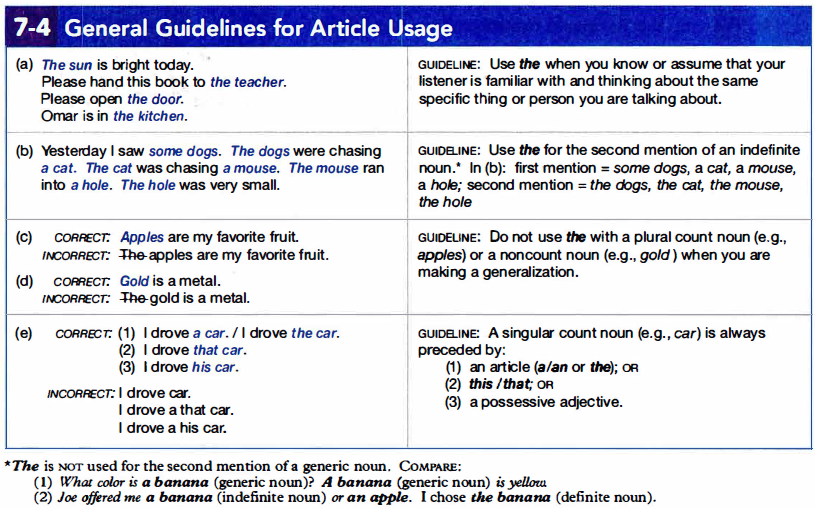
✅ Use “a” or “an” when mentioning something for the first time.
✅ Use “the” when referring to something specific or already mentioned.
✅ Do not use an article before plural or noncount nouns when talking about them generally.
🔹 No Article with General Concepts:
✅ Happiness is important. (Not The happiness is important.)
✅ Music is relaxing. (Not The music is relaxing. unless referring to specific music)
🔹 Use the for Unique Objects:
✅ The sun, the moon, the sky, the earth.
🔹 Use the for Specific Groups of People or Objects:
✅ The police, the government, the United Nations.
🚨 Common Mistakes:
❌ The happiness is important. → ✅ Happiness is important.
7-5. Using The or O with Titles and Geographic Names

🔹 When to Use The
✅ The United States, The Netherlands, The Philippines. (Countries with plural names)
✅ The Pacific Ocean, The Amazon River, The Himalayas. (Oceans, rivers, mountain ranges)
✅ The White House, The Empire State Building. (Famous buildings)
✅ The Eiffel Tower, The Great Wall of China. (Unique landmarks)
🔹 When to Omit The
✅ Canada, Japan, Brazil. (Most country names)
✅ Mount Everest, Lake Victoria, Central Park. (Mountains, lakes, parks)
✅ Times Square, Buckingham Palace. (Specific places with proper names)
🚨 Common Mistakes:
❌ The Canada is beautiful. → ✅ Canada is beautiful.
❌ We visited The Mount Everest. → ✅ We visited Mount Everest.
8. PRONOUNS

Pronouns replace nouns to avoid repetition and make sentences clearer. They agree with the nouns they replace in number, gender, and case.
There are different types of pronouns, such as personal pronouns, possessive pronouns, reflexive pronouns, and impersonal pronouns. Understanding their correct usage is essential for fluent and natural English.
What you will learn:
- Personal pronouns replace nouns (he, she, they), while possessive adjectives show ownership (my, your, their).
- Use “their” for generic nouns (e.g., Everyone should bring their book).
- Collective nouns can be singular or plural, depending on the meaning.
- Reflexive pronouns are used when the subject and object are the same (He hurt himself).
- “You,” “One,” and “They” can be impersonal pronouns used for general statements.
- “Other,” “Another,” “The Other,” and “Others” have different uses—be careful with their distinctions.
- Common expressions like “each other” and “one another” indicate reciprocal actions.
8-1. Pronouns and Possessive Adjectives


🔹 Personal Pronouns
- Replace specific nouns referring to people, places, or things.
✅ She is my friend. (She replaces Lisa.)
✅ They are playing football. (They replaces John and Mark.)
🔹 Possessive Adjectives
- Show ownership or relationship and come before a noun.
✅ This is my book. (Not This is mine book.)
✅ Their house is big. (Not Theirs house is big.)
🚨 Common Mistakes:
❌ This is yours pencil. → ✅ This is your pencil.
❌ That car is her. → ✅ That car is hers.
8-2. Agreement with Generic Nouns and Indefinite Pronouns

🔹 Generic Nouns
- Refer to general people or things, not specific ones.
✅ A teacher should care about his or her students. (More formal)
✅ A teacher should care about their students. (More natural in spoken English)
🔹 Indefinite Pronouns
- Refer to an unknown or unspecified person or thing.
✅ Someone left their bag here. (Singular “someone”, but “their” is used in informal English.)
✅ Everybody should do their best. (Common in modern English)
🚨 Common Mistakes:
❌ Everyone should bring his book. → ✅ Everyone should bring their book. (More natural)
8-3. Personal Pronouns: Agreement with Collective Nouns

- Collective nouns (e.g., team, family, audience) can be singular or plural, depending on whether the group is seen as one unit or as individuals.
✅ The team is winning its game. (Team as one unit → singular)
✅ The team are arguing among themselves. (Team as individuals → plural)
🚨 Common Mistakes:
❌ The jury has reached their decision. → ✅ The jury has reached its decision.
8-4. Reflexive Pronouns

🔹 Reflexive Pronouns (myself, yourself, himself, herself, itself, ourselves, yourselves, themselves)
- Used when the subject and object are the same person.
✅ I hurt myself while cooking.
✅ She taught herself how to play the piano.
🔹 Intensive Use
- Used for emphasis.
✅ I made this cake myself.
✅ The president himself attended the meeting.
🚨 Common Mistakes:
❌ He hurt hisself. → ✅ He hurt himself.
❌ I myself don’t know the answer. (Correct but redundant – I don’t know the answer is enough.)
8-5. Using You, One, and They as Impersonal Pronouns

🔹 “You” (General Meaning)
- Used when giving instructions or talking about people in general.
✅ You should always tell the truth. (general advice)
🔹 “One” (More Formal)
- Used in formal English or writing.
✅ One should always be polite. (formal rule)
🔹 “They” (Refers to an Unknown Person or Group)
- Used when the exact subject is unknown or unimportant.
✅ They say it’s going to rain tomorrow. (people in general)
✅ Someone called, but they didn’t leave a message. (gender-neutral pronoun)
🚨 Common Mistakes:
❌ One should always do your best. → ✅ One should always do one’s best. (Formal agreement)
8-6. Forms of Other

🔹 “Other” (Adjective or Pronoun)
- Refers to something different or additional.
✅ I have two brothers. One is a doctor; the other is a teacher.
✅ Do you have any other questions?
🔹 “Another” (One More or Additional)
- Refers to one more thing or person.
✅ I need another cup of coffee.
✅ Can I have another slice of cake?
🔹 “Others” (Plural of “Other”)
- Refers to more people or things.
✅ Some students are studying; others are playing.
🚨 Common Mistakes:
❌ I want other apple. → ✅ I want another apple.
8-7. Common Expressions with Other

-
Each other / One another (for reciprocal actions)
✅ They love each other. (Two people)
✅ The players congratulated one another. (More than two people) -
The other day = A few days ago
✅ I saw Tom the other day. -
Every other = Alternating
✅ We have meetings every other Monday.
🚨 Common Mistakes:
❌ They helped themselves. (Incorrect if talking about two people helping each other → use each other)
9. MODALS, PART1

Modals are helping (auxiliary) verbs that express ability, necessity, possibility, permission, requests, and suggestions. Unlike regular verbs, they do not change form based on the subject.
For example:
✅ She can swim. (Ability)
✅ You must wear a seatbelt. (Necessity)
✅ May I leave early? (Permission)
What you will learn:
- Modals are followed by the base form of the verb (e.g., She must go).
- Must, Have to, and Have Got To express necessity, but must is stronger.
- Not have to = Lack of necessity, while must not = Prohibition.
- Should, Ought To, Had Better, and Could express advice.
- Be supposed to and Should indicate expectation.
- Can, Know How To, and Be Able To express ability.
- Can, May, and Might express possibility, but may/might indicate uncertainty.
- Could, Can, Would You Mind are used for polite requests.
- Let’s, Why Don’t We, and Shall I/We are used for suggestions.
9-1. Basic Modal Introduction

Common Modals:
✅ Can, Could, May, Might, Must, Shall, Should, Will, Would
Rules:
-
Modals are followed by the base form of the verb (no to).
✅ She can dance. (Not She can to dance.)
✅ He should go. (Not He should goes.) -
No third-person singular (-s) changes.
✅ He must study. (Not He musts study.) -
Questions and negatives don’t need auxiliary verbs (do/does/did).
✅ Can you help me? (Not Do you can help me?)
✅ She must not go. (Not She doesn’t must go.)
9-2. Expressing Necessity: Must, Have To, Have Got To

🔹 Must → Strong necessity / obligation
✅ You must wear a helmet when riding a bike.
🔹 Have to → General necessity
✅ I have to wake up early for work.
🔹 Have got to → Informal necessity
✅ I’ve got to call my mom.
🚨 Differences:
- Must is often used for rules or personal opinions.
- Have to is more common in daily conversation.
- Have got to is mainly spoken and informal.
9-3. Lack of Necessity (Not Have To) and Prohibition (Must Not)

🔹 Lack of Necessity (Not Have To)
- Something is not necessary, but it’s allowed.
✅ You don’t have to wear a tie at work. (It’s optional.)
🔹 Prohibition (Must Not)
- Something is not allowed (strict rule).
✅ You must not smoke inside the building. (It’s forbidden.)
🚨 Common Mistakes:
❌ You must not go to school today. (Incorrect if it’s a choice.)
✅ You don’t have to go to school today. (Correct – it’s optional.)
9-4. Advisability/Suggestions: Should, Ought To, Had Better, Could

🔹 Should / Ought to → Advice or recommendation
✅ You should eat more vegetables.
✅ You ought to apologize to her.
🔹 Had better → Strong advice (warning of consequences)
✅ You had better leave now, or you’ll be late.
🔹 Could → Mild suggestion
✅ You could try this new restaurant. (Optional)
🚨 Common Mistakes:
❌ You should to see a doctor. → ✅ You should see a doctor.
9-5. Expectation: Be Supposed To / Should
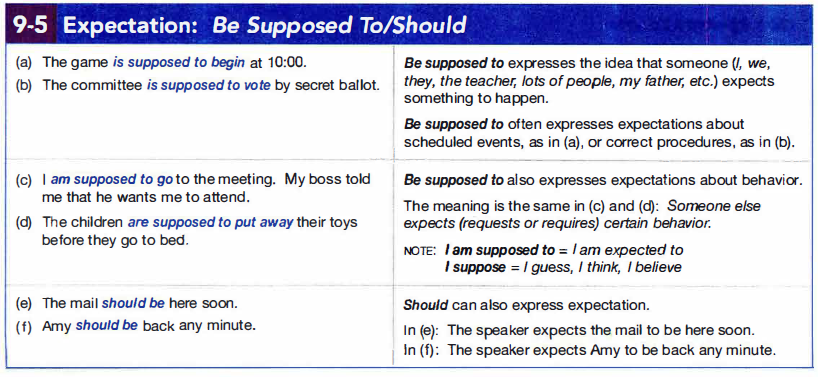
🔹 Be supposed to → Expectation based on rules or plans
✅ You are supposed to arrive at 8 AM.
🔹 Should → General expectation
✅ The train should arrive soon.
🚨 Common Mistakes:
❌ She is supposed go to the meeting. → ✅ She is supposed to go to the meeting.
9-6. Ability: Can, Know How To, and Be Able To

🔹 Can → General ability
✅ He can swim.
🔹 Know how to → Specific learned skill
✅ She knows how to play the piano.
🔹 Be able to → More formal version of “can”
✅ He is able to lift 100 kg.
🚨 Common Mistakes:
❌ I can to cook. → ✅ I can cook.
9-7. Possibility: Can, May, Might

🔹 Can → General possibility
✅ Accidents can happen anytime.
🔹 May / Might → Uncertain possibility
✅ It may rain tomorrow.
✅ She might be at home now.
🚨 Common Mistakes:
❌ It can rain later. → ✅ It may rain later.
9-8. Requests and Responses with Modals

🔹 Making Requests
- Polite: Could you help me?
- Neutral: Can you help me?
- More Formal: Would you mind helping me?
🔹 Responding to Requests
✅ Sure, I’d be happy to. (Polite)
✅ Sorry, I can’t right now. (Declining)
🚨 Common Mistakes:
❌ Can you to help me? → ✅ Can you help me?
9-9. Polite Requests with Would You Mind

✅ Would you mind opening the window?
✅ Would you mind if I sat here?
🚨 Key Rule:
- If the request is for someone else, use -ing. (Would you mind turning off the music?)
- If the request is for yourself, use past tense. (Would you mind if I left early?)
9-10. Making Suggestions: Let's, Why Don't, Shall I / We

🔹 Let’s → Including yourself in a suggestion
✅ Let’s go to the beach!
🔹 Why don’t we → Casual suggestion
✅ Why don’t we try a new restaurant?
🔹 Shall I / Shall we → Formal or British English
✅ Shall we go for a walk?
🚨 Common Mistakes:
❌ Let’s to go out. → ✅ Let’s go out.
10. MODALS, PART2

Modals help express past habits, necessity, ability, certainty, and preferences. In this section, we focus on modals in past and future contexts and how they indicate different levels of certainty.
What you will learn:
- Would expresses repeated past actions, but not states.
- Had to shows past necessity, while should have expresses past advisability.
- Could / Was able to show past ability, but “was able to” is used for specific events.
- Must, May, Might, Could, Can’t express certainty and possibility in present, past, and future.
- Progressive forms of modals show actions in progress.
- Would rather expresses preference for oneself or others.
- Modal combinations help refine meaning, like may have to or should be able to.
10-1. Using Would to Express a Repeated Action in the Past

🔹 Would is used for actions that happened repeatedly in the past (similar to used to).
✅ When I was a child, we would go to the beach every summer.
✅ She would always tell funny stories at dinner.
🚨 Key Differences:
-
Would is used only for actions (not states).
❌ I would be shy as a kid. → ✅ I used to be shy as a kid. -
Used to can be used for both actions and states.
✅ She used to have long hair.
10-2. Expressing the Past: Necessity, Advisability, Expectation

🔹 Past Necessity
-
Had to expresses a necessity in the past.
✅ I had to study hard for the exam. -
Must have + past participle expresses a strong assumption.
✅ She must have forgotten her keys.
🔹 Past Advisability
-
Should have + past participle expresses regret or missed advice.
✅ You should have told me earlier. -
Ought to have + past participle is similar but less common.
✅ He ought to have apologized.
🔹 Past Expectation
- Was/Were supposed to shows something that was expected but may not have happened.
✅ He was supposed to call me, but he didn’t.
10-3. Expressing Past Ability

🔹 Could + base verb
- Expresses general past ability
✅ She could run fast when she was younger.
🔹 Was/Were able to + base verb
- Used for specific past actions
✅ I was able to fix my car yesterday.
🚨 Key Difference:
❌ I could fix my car yesterday. → ✅ I was able to fix my car yesterday. (One-time event)
10-4. Degress of Certainty: Present Time

🔹 Expressing Certainty
-
Must + base verb → Strong certainty
✅ She must be at work (I’m almost sure). -
May/Might/Could + base verb → Possibility
✅ He may be sleeping (I’m not sure). -
Can is NOT used for certainty.
❌ He can be at home. → ✅ He may be at home.
10-5. Degress of Certainty: Present Time Negative

-
Can’t / Couldn’t + base verb → Strong impossibility
✅ He can’t be the thief. He was with me!
✅ That couldn’t be true! -
May not / Might not + base verb → Uncertain possibility
✅ She might not be home yet.
🚨 Common Mistakes:
❌ She can’t be home yet (when unsure). → ✅ She might not be home yet.
10-6. Degress of Certainty: Past Time

-
Must have + past participle → Strong certainty
✅ She must have left early. -
May have / Might have + past participle → Possibility
✅ He might have forgotten the meeting. -
Could have + past participle → Uncertain possibility
✅ They could have taken a different route. -
Can’t have / Couldn’t have + past participle → Strong impossibility
✅ She can’t have finished that fast!
🚨 Common Mistakes:
❌ She must left early. → ✅ She must have left early.
10-7. Degrees of Certainty: Future Time

-
Must / Should + base verb → Strong certainty
✅ She must arrive soon. -
May / Might / Could + base verb → Uncertainty
✅ It may rain tomorrow. -
Can’t / Couldn’t + base verb → Strong impossibility
✅ She can’t win if she doesn’t try.
10-8. Progressive Forms of Modals

🔹 Used to express actions in progress at a specific time
✅ She must be sleeping now.
✅ He might be working late.
🔹 Past Progressive Modals
✅ She must have been sleeping when we called.
✅ He could have been driving when you texted him.
🚨 Common Mistakes:
❌ She must sleeping. → ✅ She must be sleeping.
10-9. Combining Modals with Phrasal Modals

🔹 Combining modals and phrasal modals (modal-like expressions)
✅ She may have to leave early.
✅ He should be able to fix it.
🚨 Common Mistakes:
❌ She must to go. → ✅ She must go.
10-10. Expressing Preference: Would Rather

🔹 Would rather + base verb → Expresses preference
✅ I would rather stay home than go out.
✅ She’d rather drink tea than coffee.
🔹 Would rather + subject + past verb → Expressing preference for someone else
✅ I’d rather you stayed home tonight.
✅ She’d rather we left now.
🚨 Common Mistakes:
❌ I’d rather to stay home. → ✅ I’d rather stay home.
10-11. Summary Chart of Modals and Similar Expressions




| Function | Modal/Phrase | Example |
|---|---|---|
| Past Habit | Would / Used to | She would visit her grandma every summer. |
| Past Necessity | Had to | I had to wake up early. |
| Past Ability | Could / Was able to | He could swim at age 5. |
| Past Advisability | Should have / Ought to have | You should have studied more. |
| Degrees of Certainty (Present) | Must / May / Might / Can’t | She must be tired. |
| Degrees of Certainty (Past) | Must have / May have / Couldn’t have | He must have forgotten. |
| Future Possibility | May / Might / Could | It might rain tomorrow. |
| Preference | Would rather | I’d rather sleep than work late. |
11. THE PASSIVE

The passive voice is a grammatical construction where the focus is on the action rather than the doer (agent). It is commonly used in academic writing, news reports, and formal situations.
Example:
✅ A cake was baked by Sarah. (Passive)
❌ Sarah baked a cake. (Active)
What you will learn:
✅ Passive voice focuses on the action, not the doer.
✅ Formed with "to be" + past participle (V3).
✅ Used in: formal writing, science, news, and avoiding blame.
✅ Modals in passive: must be done, can be seen, should be repaired.
✅ Stative passive expresses a state (interested in, married to).
✅ “Get” passive is informal (got fired, got injured).
✅ “-ed” vs “-ing” adjectives: excited (feeling) vs exciting (causing the feeling).
11-1. Active vs Pasive

- Active voice: The subject performs the action.
- She wrote a letter. (Subject → Verb → Object)
- Passive voice: The object becomes the focus, and the subject is often omitted or introduced with “by”.
- A letter was written (by her).
🔹 When to use passive?
✅ When the doer is unknown: A new law was passed.
✅ When the focus is on the action: The bridge was built in 1990.
✅ When being formal or impersonal: Mistakes were made.
11-2. Tense Forms of the Passive

The passive can be formed in different tenses. The structure is:
👉 Subject + “to be” (conjugated) + Past Participle (V3)
| Tense | Active | Passive |
|---|---|---|
| Present Simple | She writes a book. | A book is written. |
| Present Continuous | She is writing a book. | A book is being written. |
| Past Simple | She wrote a book. | A book was written. |
| Past Continuous | She was writing a book. | A book was being written. |
| Future Simple | She will write a book. | A book will be written. |
| Present Perfect | She has written a book. | A book has been written. |
| Past Perfect | She had written a book. | A book had been written. |
📝 Example:
✅ The documents were printed yesterday. (Past Simple)
✅ The project is being completed now. (Present Continuous)
11-3. Using the Passive

The passive is used in various contexts:
✅ Formal Writing:
- A new policy was introduced by the government.
✅ Scientific & Technical Writing:
- The experiment was conducted successfully.
✅ News Reports:
- A famous painting was stolen last night.
✅ Avoiding Blame:
- Mistakes were made (by someone).
💡 Tip: If the agent (who did the action) is important, we can add “by”:
- The song was sung by Adele.
11-4. The Passive Form of Modals and Phrasal Modals


Modals like can, must, should, might can also be used in passive voice.
👉 Modal + be + Past Participle
| Modal Active | Passive Version |
|---|---|
| She can fix the car. | The car can be fixed. |
| They must complete the form. | The form must be completed. |
| He should clean the room. | The room should be cleaned. |
🔹 Phrasal modals (e.g., “have to”, “be going to”) also follow this rule:
- She has to finish the project. → The project has to be finished.
- They are going to build a new mall. → A new mall is going to be built.
11-5. Stative (Non-Progressive) Passive

Some passive verbs describe a state rather than an action. These are called stative passives.
🚫 They do NOT use the continuous (-ing) form!
✅ The door is closed. (State)
❌ The door is being closed. (Not stative)
Common stative passives:
- The house is located downtown.
- She is interested in science.
- The table is covered with dust.
11-6. Common Stative (Non-Progressive) Passive Verbs + Prepositions

Many stative passive verbs are followed by specific prepositions.
| Verb | Preposition | Example |
|---|---|---|
| Be interested | in | She is interested in art. |
| Be known | for | He is known for his kindness. |
| Be worried | about | I am worried about my exam. |
| Be satisfied | with | We are satisfied with the results. |
| Be married | to | She is married to a doctor. |
💡 Tip: Memorizing these combinations will help you sound more natural!
11-7. The Passive with Get

Instead of “be,” we can use “get” in informal situations.
✅ He got promoted last week!
✅ My phone got stolen!
✅ They got married last year.
🔹 Difference between “be” and “get” passives:
- “Be” is more formal. (The window was broken.)
- “Get” is more casual. (The window got broken.)
11-8. -ed/-ing Adjectives

Some adjectives come from verbs and use -ed or -ing endings.
-ed Adjectives (feelings) |
-ing Adjectives (causing feelings) |
|---|---|
| I am bored. | This movie is boring. |
| She feels tired. | The work is tiring. |
| They were interested. | The book is interesting. |
💡 Rule of thumb:
-ed→ How someone feels (I am confused.)-ing→ How something makes you feel (The lesson is confusing.)
12. NOUN CLAUSES

A noun clause is a dependent clause that acts as a noun in a sentence. It can be a subject, object, or complement and usually starts with words like that, if, whether, who, what, when, where, why, how.
✅ Example:
- I don’t know what she wants. (Noun clause as an object)
- What he said was surprising. (Noun clause as a subject)
What you will learn:
✅ Noun clauses act like nouns (subjects, objects, complements).
✅ They start with words like “that,” “who,” “what,” “when,” “where,” “why,” “how,” “if,” “whether”.
✅ No question word order in noun clauses (I know where she is, not I know where is she ❌).
✅ Reported speech changes verb tenses, pronouns, and time expressions.
✅ Modal verbs change in reported speech (can → could, will → would, must → had to).
✅ The subjunctive is used in suggestions and necessity (She insisted that he be on time).
12-1. Introduction

🔹 A noun clause replaces a noun in a sentence.
🔹 It often answers “what?” or “who?” about the main verb.
🔹 It starts with words like that, what, when, where, why, how, who, whether, if.
✅ Example:
- She believes that he is honest. (noun clause as an object)
- Where she lives is a mystery. (noun clause as a subject)
12-2. Noun Clauses with Question Words


Noun clauses often start with wh- question words:
👉 who, what, when, where, why, how
✅ Examples:
- I don’t know where she went. (object)
- Why he left is a mystery. (subject)
🔹 NO question word order!
🚫 I don’t know where did she go. ❌
✅ I don’t know where she went. ✅
12-3. Noun Clauses with Whether or If
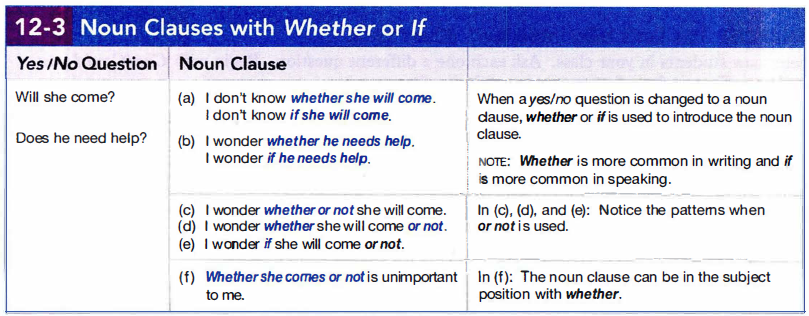
Use whether or if to introduce a yes/no question in a noun clause.
✅ Examples:
- I don’t know if she is coming.
- Can you tell me whether it will rain?
- She asked whether we had finished.
🔹 “Whether” is more formal than “if”.
🔹 Use “whether” before “or not”:
✅ She asked whether or not we would attend.
🚫 She asked if or not we would attend. ❌
12-4. Question Words Followed by Infinitives

Noun clauses sometimes use wh- words + an infinitive (to + verb).
✅ Examples:
- I don’t know what to do.
- He explained how to solve the problem.
- Tell me where to go.
🔹 These structures replace a full noun clause:
✅ I don’t know how I should fix it. → I don’t know how to fix it.
12-5. Noun Clauses with That
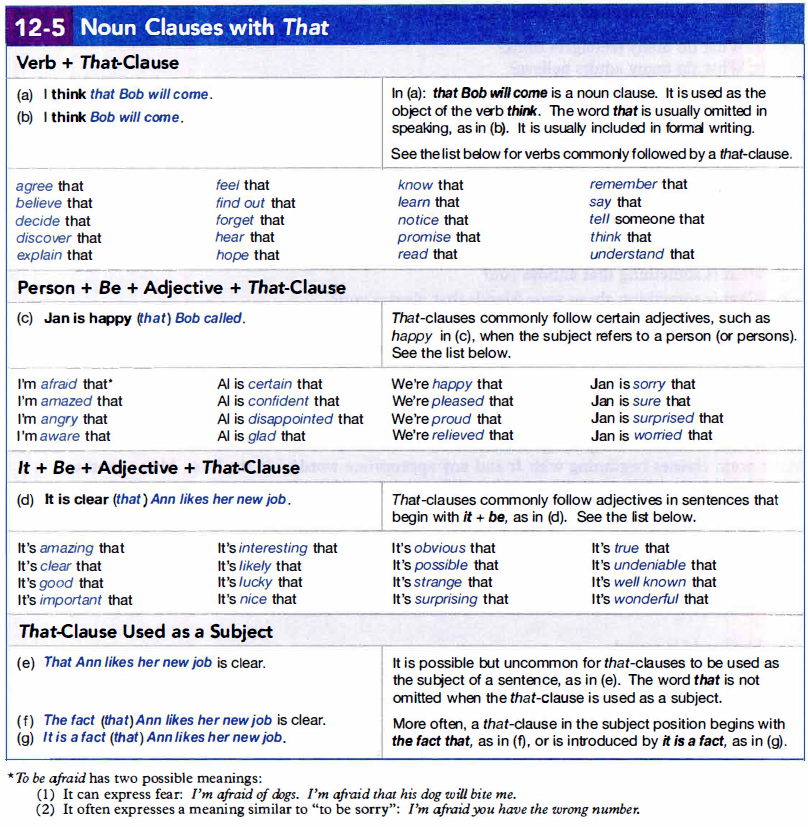
The word “that” introduces noun clauses but is often omitted in casual speech.
✅ Examples:
- She believes (that) he is right.
- I know (that) she passed the test.
🔹 “That” is required when the noun clause is the subject:
✅ That she left early surprised me.
🚫 She left early surprised me. ❌
12-6. Quoted Speech

Quoted speech (direct speech) repeats someone’s exact words.
✅ Examples:
- She said, “I am tired.”
- He asked, “Where are you going?”
🔹 Rules for Quoted Speech:
✅ Use quotation marks (“…”)
✅ Keep the original word order
✅ Keep the same verb tense
12-7. Reported Speech

Reported speech (indirect speech) tells what someone said without using their exact words.
✅ Examples:
- Quoted speech: She said, “I am tired.”
- Reported speech: She said (that) she was tired.
🔹 Changes in reported speech:
| Direct Speech | Reported Speech |
|---|---|
| “I am happy.” | She said she was happy. |
| “He will call.” | She said he would call. |
| “They are working.” | She said they were working. |
🔹 Pronouns and time expressions also change:
| Direct Speech | Reported Speech |
|---|---|
| “I like this book.” | She said she liked that book. |
| “We went yesterday.” | She said they had gone the day before. |
| “I will go tomorrow.” | She said she would go the next day. |
12-8. Reported Speech: Modal Verbs in Noun Clauses

Modal verbs change in reported speech:
| Direct Speech | Reported Speech |
|---|---|
| “I can swim.” | She said she could swim. |
| “They must leave.” | She said they had to leave. |
| “He will call.” | She said he would call. |
🔹 Some modals don’t change:
- She said, “I should study.” → She said she should study.
- He said, “I might be late.” → He said he might be late.
12-9. The Subjunctive in Noun Clauses

The subjunctive is used in noun clauses after verbs expressing necessity, suggestion, or importance.
🔹 Common verbs: suggest, recommend, insist, demand, require, advise
✅ Examples:
- She insisted that he be on time.
- The teacher recommended that we study more.
- It is necessary that she leave immediately.
🔹 Subjunctive structure:
✅ (that) + subject + base verb (no -s or past form!)
🚫 She insisted that he is on time. ❌
✅ She insisted that he be on time. ✅
13. ADJECTIVE CLAUSES

An adjective clause (also called a relative clause) is a dependent clause that acts as an adjective, meaning it describes a noun. It usually starts with who, whom, whose, which, that, where, or when and gives more information about a noun.
✅ Examples:
- The girl who won the race is my friend. (Describes “the girl”)
- The book that I borrowed is amazing. (Describes “the book”)
- She lives in a city where it never snows. (Describes “a city”)
What you will learn:
✅ Adjective clauses describe nouns and start with who, whom, whose, which, that, where, when.
✅ “Who” for people, “which” for things, “that” for both.
✅ Omit “that/which/who” if it’s an object (The book (that) I read was good.).
✅ Use commas for non-restrictive clauses (My car, which is old, runs well.).
✅ Use “where” for places, “when” for time.
✅ Reduce adjective clauses by removing “who/which” + “be” verb.
13-1. Adjective Clause Pronouns Used as the Subject

When the relative pronoun (who, which, that) is the subject of the adjective clause, it is followed by a verb.
✅ Examples:
- The teacher who teaches English is very kind.
- The car that broke down belongs to John.
- The book which is on the table is mine.
🔹 “Who” is used for people, “which” is used for things, and “that” can be used for both.
🚫 The man he is my friend. ❌
✅ The man who is my friend is kind. ✅
13-2. Adjective Clause Pronouns Used as the Object of a Verb

When the relative pronoun is the object of a verb, it can be omitted in informal English.
✅ Examples:
- The book (that) I read was interesting.
- The woman (whom) we met was nice.
- The movie (which) I watched was scary.
🔹 “Whom” is formal, but “who” is commonly used in spoken English.
🚫 The book I read it was interesting. ❌
✅ The book I read was interesting. ✅
13-3. Adjective Clause Pronouns Used as the Object of a Preposition

When the relative pronoun is the object of a preposition, the preposition can come before or after the clause.
✅ Examples:
- The man to whom I spoke was helpful. (Formal)
- The man who I spoke to was helpful. (Casual)
- The house in which she lives is beautiful. (Formal)
- The house that she lives in is beautiful. (Casual)
🔹 In spoken English, we usually put the preposition at the end and use who/that instead of whom/which.
🚫 The woman to who I talked was nice. ❌
✅ The woman who I talked to was nice. ✅
13-4. Using Whose

“Whose” shows possession and replaces “his, her, their, its”.
✅ Examples:
- The boy whose father is a doctor is my friend.
- I met a woman whose car was stolen.
- The company whose products are popular is expanding.
🔹 “Whose” is used for both people and things.
🚫 The man who his car was stolen is upset. ❌
✅ The man whose car was stolen is upset. ✅
13-5. Using Where in Adjective Clauses

“Where” is used to modify places. It can replace “in which” or “at which”.
✅ Examples:
- This is the city where I was born. (= This is the city in which I was born.)
- The school where she studies is famous.
- That’s the restaurant where we met.
🚫 This is the city which I was born in. ❌
✅ This is the city where I was born. ✅
13-6. Using When in Adjective Clauses

“When” is used to modify time expressions. It can replace “in which” or “at which”.
✅ Examples:
- I remember the day when we first met. (= I remember the day on which we first met.)
- Summer is the season when we go to the beach.
- Do you remember the time when we got lost?.
🚫 I remember the day which we first met on. ❌
✅ I remember the day when we first met. ✅
13-7. Using Adjective Clauses to Modify Pronouns

Adjective clauses can modify indefinite pronouns like someone, anyone, everything, nothing, something.
✅ Examples:
- I need someone who can help me.
- Is there anything that I can do?
- She wants something that tastes sweet.
🚫 I need someone he can help me. ❌
✅ I need someone who can help me. ✅
13-8. Punctuating Adjective Clauses

🔹 Restrictive Clauses (Necessary) – No Commas
- The book that I borrowed is interesting.
- The students who study hard pass the exam.
🔹 Non-Restrictive Clauses (Extra Information) – Use Commas
- My car, which is very old, still runs well.
- John, who is my friend, loves music.
🚫 My friend who is a doctor is smart. (Wrong if you have many friends)
✅ My friend, who is a doctor, is smart. (Correct for one friend)
13-9. Using Expressions of Quantity in Adjective Clauses

We can use “some of,” “many of,” “none of,” “all of,” “half of” + whom/which in adjective clauses.
✅ Examples:
- I met ten people, some of whom were doctors.
- She has many books, most of which are in English.
- He told me several stories, none of which were true.
🚫 She has five cats, most of them are black. ❌
✅ She has five cats, most of which are black. ✅
13-10. Using Which to Modify a Whole Sentence
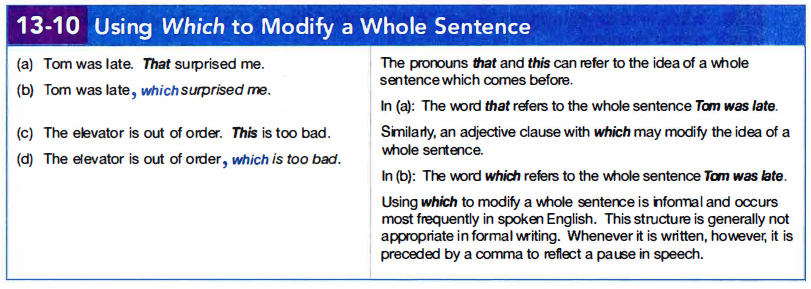
“Which” can modify an entire sentence, not just a noun.
✅ Examples:
- He was late, which annoyed me. (Refers to the fact that he was late)
- She passed the test, which made her happy.
- Tom forgot his wallet, which was a problem.
🚫 Tom forgot his wallet, that was a problem. ❌
✅ Tom forgot his wallet, which was a problem. ✅
13-11. Reducing Adjective Clauses to Adjective Phrases

We can shorten adjective clauses to adjective phrases by removing the relative pronoun and “be” verb.
✅ Examples:
- The man who is talking is my brother. → The man talking is my brother.
- The book which was written by her is famous. → The book written by her is famous.
🚫 The man talking is my brother to. ❌
✅ The man talking is my brother. ✅
14. GERUNDS AND INFINITIVES PART1

Gerunds (verb + -ing) and infinitives (to + verb) can act as nouns and function as subjects, objects, or complements in a sentence. However, some verbs only take gerunds, others only take infinitives, and some can take both with a difference in meaning.
What you will learn:
✅ Gerunds (-ing) and infinitives (to + verb) can act as nouns.
✅ Some verbs always take gerunds, some always take infinitives, and some can take both with different meanings.
✅ Gerunds follow prepositions (interested in learning).
✅ “Go” + gerund is used for activities (go swimming, go hiking).
✅ Infinitives are common after adjectives and “it” (It’s easy to learn).
✅ Expressions like “It’s no use” and “I can’t help” always take gerunds.
14a. Gerunds and Infinitives: Introduction

🔹 A gerund is a verb ending in -ing that functions as a noun.
🔹 An infinitive is the base form of a verb with “to”.
🔹 Both can act as the subject or object in a sentence.
✅ Examples:
- Swimming is fun. (Gerund as subject)
- To swim is fun. (Infinitive as subject)
- I enjoy swimming. (Gerund as object)
- I want to swim. (Infinitive as object)
🚨 Gerunds are more common as subjects.
🚫 To swim is fun. (Uncommon)
✅ Swimming is fun. (Natural)
14b. Common Verbs Followed by Gerunds
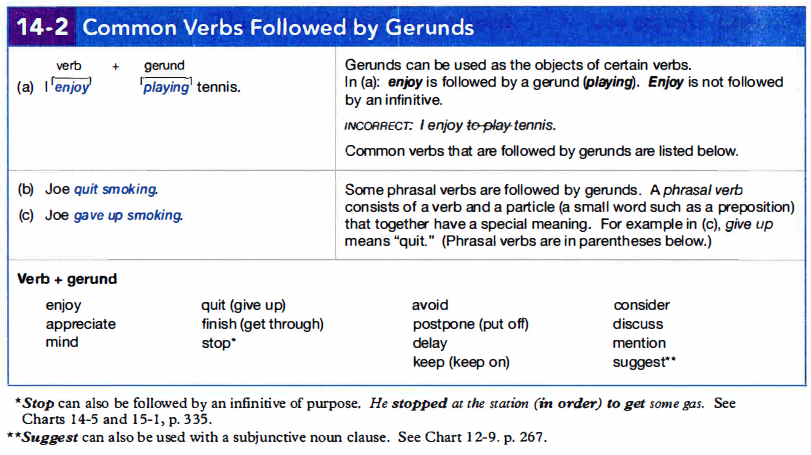
Some verbs are always followed by a gerund.
✅ Examples:
- I enjoy reading.
- She avoids talking to strangers.
- They finished studying late.
🔹 Common verbs followed by gerunds:
👉 enjoy, avoid, consider, suggest, mind, delay, miss, practice, finish, keep, deny
🚫 I enjoy to read. ❌
✅ I enjoy reading. ✅
14c. Common Verbs Followed by Infinitives

Some verbs are always followed by an infinitive.
✅ Examples:
- I want to travel.
- He decided to leave early.
- She hopes to get a promotion.
🔹 Common verbs followed by infinitives:
👉 want, need, decide, hope, plan, learn, agree, refuse, promise, expect, fail
🚫 I want going. ❌
✅ I want to go. ✅
14d. Infinitives with Objects

When an object (someone/something) comes between the verb and the infinitive, use verb + object + infinitive.
✅ Examples:
- She told him to wait.
- I asked her to help me.
- They expect us to be there on time.
🚫 She told to wait him. ❌
✅ She told him to wait. ✅
14e. Common Verbs Followed by Either Infinitives or Gerunds
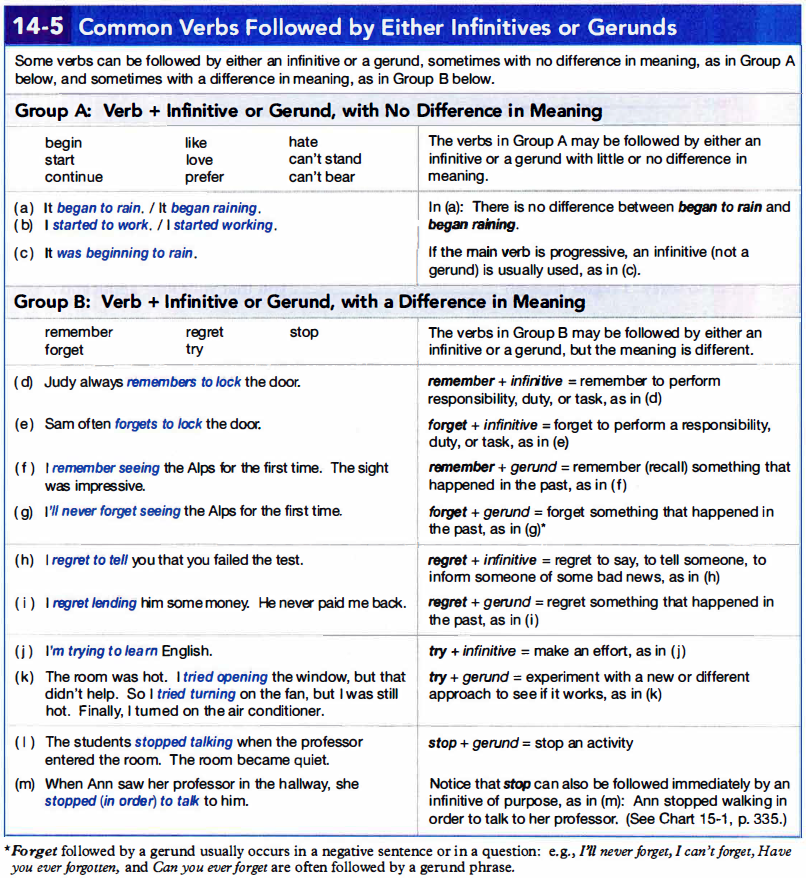
Some verbs can be followed by both gerunds and infinitives, but the meaning may change.
✅ Examples:
| Verb | Gerund (-ing) | Infinitive (to + verb) |
|---|---|---|
| Remember | I remember seeing her yesterday. (Past memory) | Remember to call me! (Future action) |
| Stop | He stopped smoking. (Quit smoking) | He stopped to smoke. (Paused to smoke) |
| Try | I tried calling her, but she didn’t answer. (Attempt method) | I tried to call her, but I had no signal. (Attempt action) |
🚨 Be careful! Some verbs change meaning with gerunds vs. infinitives.
14f. Using Gerunds as the Objects of Prepositions

🔹 After a preposition, always use a gerund (not an infinitive!).
✅ Examples:
- She’s interested in learning Spanish.
- He apologized for being late.
- They are good at swimming.
🚫 She’s interested in to learn Spanish. ❌
✅ She’s interested in learning Spanish. ✅
14g. Go + Gerund

The verb “go” is often followed by a gerund for leisure activities.
✅ Examples:
- Let’s go swimming!
- They go hiking every weekend.
- He went shopping yesterday.
🚫 Let’s go to swim! ❌
✅ Let’s go swimming! ✅
14h. Special Expressions Followed by -ing

Some phrases are always followed by a gerund.
✅ Examples:
- It’s no use complaining.
- I can’t help laughing.
- She’s busy cooking.
🔹 Common expressions followed by gerunds:
👉 It’s no use, it’s worth, can’t help, have fun, spend time, waste time, be busy
🚫 It’s no use to complain. ❌
✅ It’s no use complaining. ✅
14i. It + Infinitive; Gerunds and Infinitives as Subjects
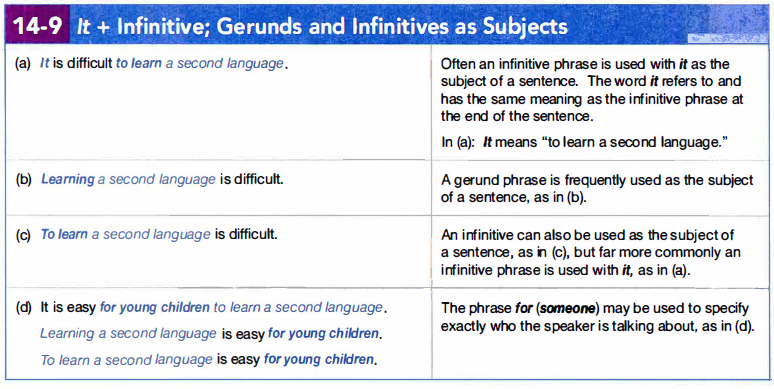
🔹 The infinitive is often used with “it” as the subject of a sentence.
✅ Examples:
- It’s important to exercise.
- It’s difficult to learn a new language.
- It was nice to meet you.
🚨 Gerunds are more natural as real subjects:
✅ Exercising is important. (Gerund)
✅ It is important to exercise. (Infinitive with “it”)
🚫 To exercise is important. ❌ (Rare)
14j. Reference List of Verbs Followed by Infinitives


🔹 Common verbs that take infinitives:
👉 agree, decide, expect, fail, hope, learn, need, offer, plan, promise, refuse, want
✅ Examples:
- She decided to move to Canada.
- I hope to see you soon.
- He refused to pay the fine.
🚫 She decided moving to Canada. ❌
✅ She decided to move to Canada. ✅
14k. Reference List of Verbs Followed by Gerunds


🔹 Common verbs that take gerunds:
👉 admit, avoid, consider, deny, dislike, enjoy, finish, keep, mind, miss, practice, suggest
✅ Examples:
- He enjoys playing football.
- She suggested taking the train.
- They avoided talking about politics.
🚫 She suggested to take the train. ❌
✅ She suggested taking the train. ✅
14l. Reference List of Preposition Combinations Followed by Gerunds

🔹 After prepositions, always use gerunds!
✅ Examples:
- She’s afraid of flying.
- He’s interested in learning French.
- They’re good at cooking.
🚫 She’s afraid of to fly. ❌
✅ She’s afraid of flying. ✅
15. GERUNDS AND INFINITIVES PART2

In this section, we continue exploring the differences and uses of gerunds (-ing form) and infinitives (to + verb) in special grammatical structures. Understanding these rules will help make sentences clearer and more natural.
What you will learn:
✅ Use “to + verb” for purpose (He left to catch the bus).
✅ Some adjectives require an infinitive (happy to help, difficult to do).
✅ “Too + adj + infinitive” for excess, “adj + enough + infinitive” for sufficiency.
✅ Passive infinitives and gerunds show being affected by an action.
✅ Past forms (“to have V3”, “having V3”) express earlier actions.
✅ “Need” can be followed by a gerund or passive infinitive (needs cleaning = needs to be cleaned).
✅ Verbs of perception use bare infinitive (completed action) or gerund (ongoing action).
✅ “Let” and “Help” take the bare infinitive (Let me go).
✅ Causative verbs (“make, have, get”) have special structures.
✅ Use a possessive before a gerund for correctness (I appreciate your coming).
15a. Infinitive of Purpose: In Order To
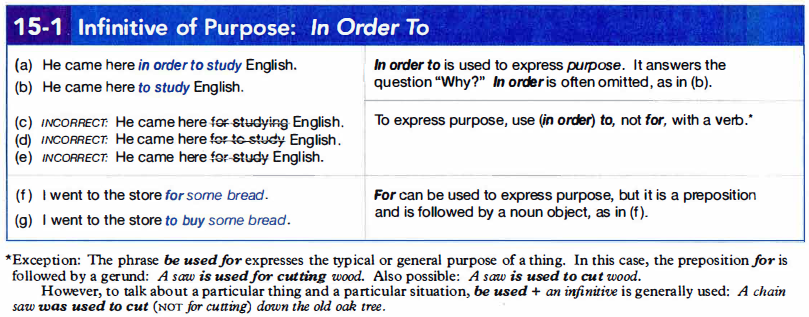
🔹 We use infinitives (to + verb) to express purpose (why something is done).
🔹 To emphasize purpose more clearly, we can use “in order to” before the infinitive.
✅ Examples:
- She studies to pass the exam.
- He left early in order to catch the bus.
- We exercise to stay healthy.
🚫 She studies for passing the exam. ❌
✅ She studies to pass the exam. ✅
📌 Key point: “In order to” is more formal but not always necessary.
15b. Adjectives Followed by Infinitives

🔹 Some adjectives are always followed by an infinitive.
🔹 These adjectives often express feelings, opinions, or judgments.
✅ Examples:
- It’s easy to learn English.
- She was happy to help.
- They were surprised to see us.
🚫 It’s easy learning English. ❌
✅ It’s easy to learn English. ✅
🔹 Common adjectives followed by infinitives:
👉 easy, hard, difficult, happy, sad, surprised, ready, afraid, eager, important
15c. Using Infinitives with Too and Enough

🔹 “Too + adjective + infinitive” expresses excess (more than necessary).
🔹 “Adjective + enough + infinitive” expresses sufficiency (the right amount).
✅ Examples:
- This coffee is too hot to drink.
- He’s too young to drive.
- She’s strong enough to lift the box.
- The room is big enough to fit everyone.
🚫 The coffee is too hot for drinking. ❌
✅ The coffee is too hot to drink. ✅
15d. Passive Infinitives and Gerundss: Present

🔹 The passive infinitive is formed using “to be + past participle (V3)”.
🔹 The passive gerund is formed using “being + past participle (V3)”.
✅ Examples:
- I don’t want to be disturbed. (Passive infinitive)
- She enjoys being praised. (Passive gerund)
🚫 I don’t want being disturbed. ❌
✅ I don’t want to be disturbed. ✅
📌 Key difference:
- “To be + V3” → Focus on a future or planned action.
- “Being + V3” → Focus on the process or experience.
15e. Past Forms of Infinitives and Gerunds: Active and Passive

🔹 The past infinitive expresses actions before another past action:
🔹 “To have + past participle (V3)”
🔹 The past gerund is used to refer to earlier completed actions:
🔹 “Having + past participle (V3)”
✅ Examples:
- She was happy to have met him. (Past infinitive)
- He admitted having lied to me. (Past gerund)
🚫 She was happy to meet him yesterday. ❌ (It should be “to have met” to show sequence)
📌 Key point:
- Use past infinitives and gerunds to show a clear sequence of actions.
15f. Using Gerunds or Passive Infinitives Following Need

🔹 After “need”, we use:
- Passive infinitive (“to be + V3”)
- Gerund in passive form (“being + V3”)
✅ Examples:
- The house needs to be cleaned.
- The car needs washing.
🚫 The house needs cleaning it. ❌
✅ The house needs to be cleaned. ✅
📌 “Need + gerund” is common in informal speech.
15g. Using Verbs of Perception

🔹 Some verbs of perception (see, hear, feel, watch, notice) are followed by:
- Gerund (-ing) → Ongoing action
- Base verb (bare infinitive) → Completed action
✅ Examples:
- I saw him running in the park. (Ongoing)
- I saw him run out the door. (Completed)
🚫 I saw him to run. ❌
✅ I saw him run. ✅
15h. Using the Simple Form After Let and Help

🔹 After “let” and “help”, use the base verb (bare infinitive).
✅ Examples:
- She let me borrow her book.
- Can you help me carry this bag?
🚫 She let me to borrow her book. ❌
✅ She let me borrow her book. ✅
15i. Using Causative Verbs: Make, Have, Get
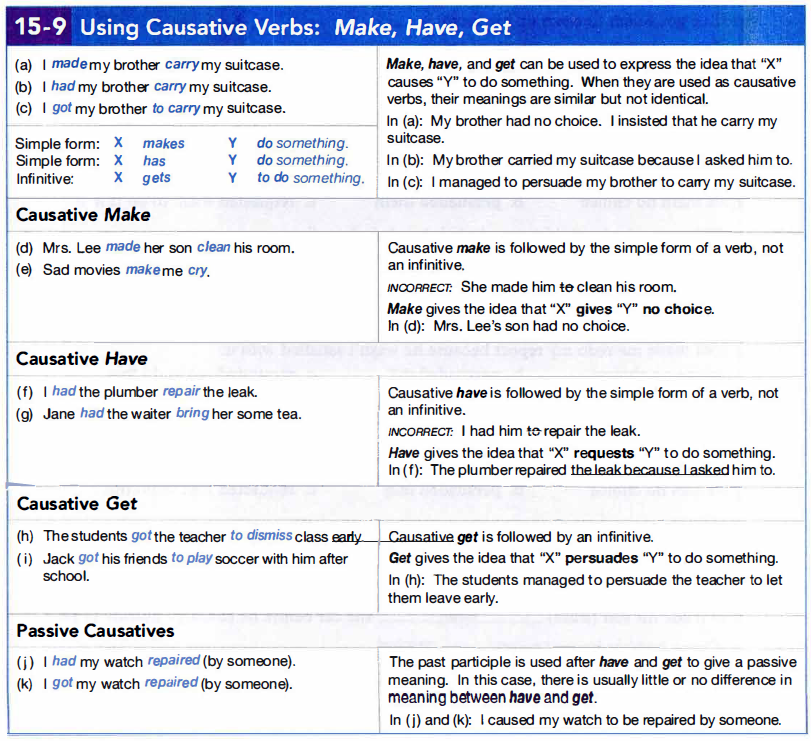
🔹 “Make” and “Have” are followed by the base verb (bare infinitive).
🔹 “Get” is followed by “to + verb”.
✅ Examples:
- She made me clean my room.
- I had my hair cut.
- He got his car repaired.
🚫 She made me to clean my room. ❌
✅ She made me clean my room. ✅
📌 Key difference: “Make” is forceful, while “Have” and “Get” are less direct.
15j. Using a Possessive to Modify a Gerund

🔹 When using a gerund as a noun, the subject can be in possessive form.
✅ Examples:
- I appreciate your helping me.
- She doesn’t like his smoking in the house.
🚫 I appreciate you helping me. (Informal but common)
✅ I appreciate your helping me. (More correct)
📌 Key point: This is more formal and precise in writing.
16. COORDINATING CONJUNCTIONS

Coordinating conjunctions are words that connect words, phrases, or independent clauses. The most common coordinating conjunctions are:
📌 FANBOYS (For, And, Nor, But, Or, Yet, So)
These words help create parallel structure, smooth connections, and clarity in writing.
What you will learn:
✅ Parallel structure ensures clarity and balance (He enjoys swimming, biking, and running).
✅ Use commas in lists, and consider using the Oxford comma for clarity (apples, oranges, and bananas).
✅ When connecting two independent clauses, use a comma + FANBOYS (She was tired, but she continued).
✅ Paired conjunctions require parallel structure (Not only smart but also kind).
16a. Parallel Structure

🔹 Parallel structure (also called parallelism) means using the same grammatical form for items in a list or series.
🔹 This creates balance, clarity, and readability in sentences.
✅ Examples:
- She likes reading, writing, and painting. (✔️ All gerunds)
- He enjoys swimming, biking, and running. (✔️ All gerunds)
- The project requires time, effort, and patience. (✔️ All nouns)
🚫 She likes reading, to write, and painting. ❌ (Mixing gerunds and infinitives)
✅ She likes reading, writing, and painting. ✔️
📌 Key point: Items in a list must be in the same grammatical form (all nouns, all verbs, etc.).
16b. Parallel Structure: Using Commas
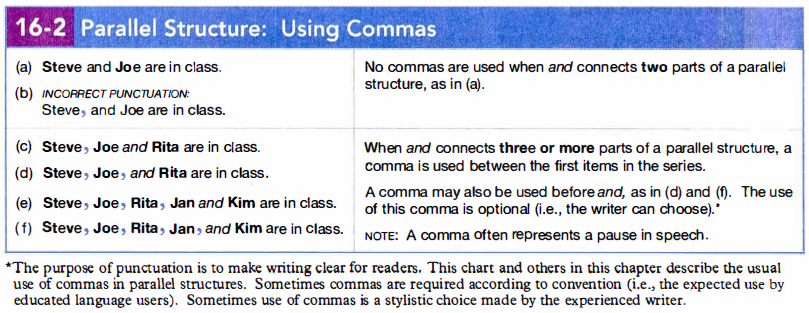
🔹 When listing three or more items, use commas to separate them.
🔹 The last comma (before “and” or “or”) is called the Oxford comma (optional in some styles).
✅ Examples:
- I bought apples, oranges, and bananas. (✔️ With Oxford comma)
- We visited Paris, London, and Rome last summer. (✔️)
🚫 I bought apples, oranges and bananas. (❌ Without the Oxford comma)
📌 Key point: The Oxford comma removes ambiguity but is optional depending on style preference.
16c. Punctuation for Independent Clauses; Connecting Them with And and But

🔹 Independent clauses are complete sentences that can stand alone.
🔹 We can connect two independent clauses using:
- A comma + coordinating conjunction (and, but, or, so, yet, for, nor).
- A semicolon (;) without a conjunction.
✅ Examples:
- She was tired, but she continued working. (✔️ Using a comma + conjunction)
- The weather was perfect; we went hiking. (✔️ Using a semicolon)
🚫 She was tired but she continued working. ❌ (Needs a comma before “but”)
📌 Key point: Use commas before “and, but, or, so” when connecting two independent clauses.
16d. Paired Conjunctions: Both ... And; Not Only ... But Also; Either .... Or; Neither ... Nor

🔹 Paired conjunctions (also called correlative conjunctions) help connect two related ideas.
🔹 These require parallel structure in the sentence.
✅ Examples:
✔ Both … And (used for two equal things)
- She is both intelligent and hardworking.
✔ Not only … But also (adds emphasis)
- He is not only smart but also kind.
✔ Either … Or (shows a choice between two things)
- You can either call me or text me.
✔ Neither … Nor (negative form of “either… or”)
- She is neither tired nor hungry.
🚫 She is both intelligent and is hardworking. ❌ (Not parallel)
✅ She is both intelligent and hardworking. ✔️
📌 Key point: Ensure the same grammatical structure follows each part of the paired conjunctions.
17. ADVERB CLAUSES

Adverb clauses are dependent clauses that modify verbs, adjectives, or other adverbs by answering questions like when, why, how, under what condition, or to what extent.
They begin with subordinating conjunctions like because, although, if, when, while, unless, even though, since, in case, etc.
What you will learn:
✅ Adverb clauses add details about time, cause, contrast, and condition.
✅ Use commas when the adverb clause comes first (Although she was tired, she kept working).
✅ Time clauses use words like when, before, after, until, since.
✅ Cause-effect clauses use because, since, so that.
✅ Contrast clauses use even though, while.
✅ Conditional clauses use if, unless, in case, whether or not, only if.
✅ Shortened if-clauses can be inverted (Had I known…).
17a. Introduction
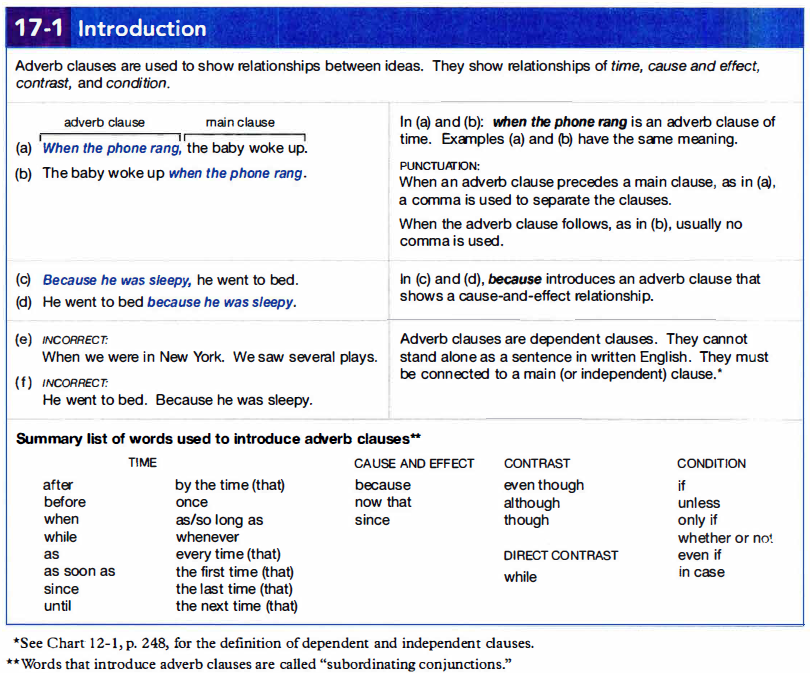
🔹 An adverb clause is a group of words with a subject and a verb that acts as an adverb.
🔹 It cannot stand alone and needs an independent clause to make a complete sentence.
🔹 These clauses add more detail about time, cause, contrast, condition, and reason.
✅ Example:
- I stayed home because it was raining. (Why? → Reason)
- She left before the meeting started. (When? → Time)
- I’ll go if you come with me. (Condition)
📌 Key point: An adverb clause always depends on the main clause to complete its meaning.
17b. Using Adverb Clauses to Show Time Relationships



🔹 Time adverb clauses show when an action happens.
🔹 These begin with when, before, after, as soon as, while, until, since.
✅ Examples:
- Call me when you arrive. (At the time of arrival)
- I finished my work before she called. (Happened earlier)
- She waited until he came back. (Up to the point he returned)
📌 Key point:
- If the adverb clause comes first, use a comma (Before she called, I finished my work).
- If the adverb clause is after the main clause, no comma is needed (I finished my work before she called).
17c. Using Adverb Clauses to Show Causes and Effect
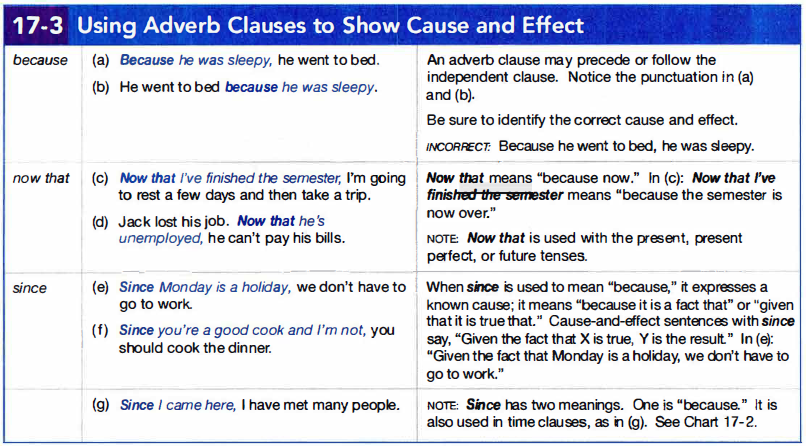
🔹 Cause and effect adverb clauses explain why something happens.
🔹 These begin with because, since, as, now that, so that.
✅ Examples:
- I stayed home because I was sick. (Reason)
- Since it was raining, we canceled the picnic. (Cause)
- She speaks loudly so that everyone can hear. (Purpose)
📌 Key point:
- “Because” is stronger than “since” or “as”.
- “So that” expresses purpose rather than direct cause.
17d. Expressing Contrast (Unexpected Result): Using Even Though

🔹 Contrast adverb clauses show an unexpected result.
🔹 Use even though, although, though to introduce contrast.
✅ Examples:
- She went to work even though she was sick. (Unexpected)
- Although he studied hard, he failed the test.
- I love chocolate though it’s not healthy.
📌 Key point: “Even though” is stronger than “although” or “though”.
17e. Showing Direct Contrast: While
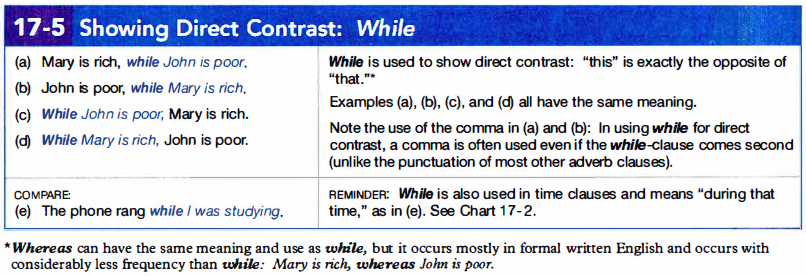
🔹 “While” is used to show a clear contrast between two actions or situations.
✅ Examples:
- He likes coffee, while she prefers tea.
- I enjoy swimming, while my brother hates it.
📌 Key point:
- “While” introduces a direct comparison between two ideas.
- The meaning differs from “while” as a time conjunction (I was reading while he was cooking).
17f. Expressing Conditions in Adverb Clauses: If-Clauses

🔹 “If”-clauses show conditions for something to happen.
🔹 These are used in conditional sentences.
✅ Examples:
- If you study, you will pass. (First conditional → possible)
- If I had studied, I would have passed. (Third conditional → past regret)
📌 Key point: “If” introduces a possible or hypothetical condition.
17g. Shortened If-Clauses

🔹 In formal writing, we can shorten “if”-clauses by removing “if” and inverting the subject and verb.
✅ Examples:
- If she were here, we would start. → Were she here, we would start.
- If I had known, I would have helped. → Had I known, I would have helped.
📌 Key point: This form is more formal and common in writing.
17h. Adverb Clauses of Condition: Using Whether Or Not and Even If
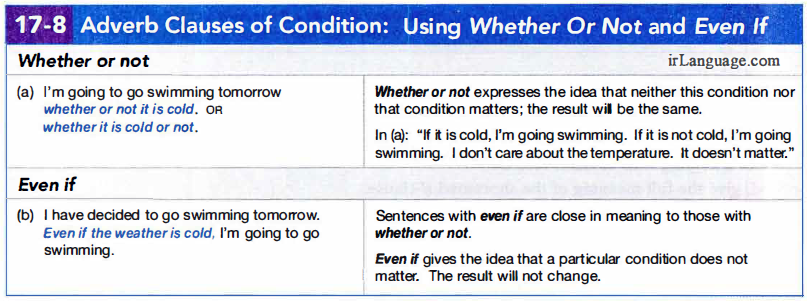
🔹 “Whether or not” shows that the result will happen no matter the condition.
🔹 “Even if” emphasizes unexpected conditions.
✅ Examples:
- I’ll go whether or not you come.
- She will help even if she is tired.
📌 Key point:
- “Whether or not” → No choice changes the outcome.
- “Even if” → Focuses on unexpected conditions.
17i. Adverb Clauses of Condition: Using In Case

🔹 “In case” means as a precaution for something that might happen.
✅ Examples:
- Take an umbrella in case it rains. (To be prepared)
- I brought extra food in case we get hungry.
📌 Key point: “In case” means preparing for a possible event.
17j. Adverb Clauses of Condition: Using Unless

🔹 “Unless” means “if not” and is used for negative conditions.
✅ Examples:
- I won’t go unless you come with me. (= I will go if you come.)
- You can’t enter unless you have a ticket.
📌 Key point:
- “Unless” replaces “if … not”.
- Avoid double negatives (I won’t go unless you don’t come ❌).
17k. Adverb Clauses of Condition: Using Only If

🔹 “Only if” sets a strict condition for something to happen.
✅ Examples:
- You can leave only if you finish your work.
- We will go out only if the weather is nice.
📌 Key point:
- “Only if” is stronger than “if”.
- When “only if” comes at the beginning, invert the subject and verb:
- Only if you study will you pass.
18. REDUCTION OF ADVERB CLAUSES TO MODIFYING ADVERBIAL PHRASES

Modifying adverbial phrases are shortened forms of adverb clauses, making sentences more concise while keeping the original meaning.
✅ Why reduce adverb clauses?
🔹 To make writing shorter and more natural.
🔹 To remove unnecessary words while keeping the meaning clear.
🔹 To avoid repetition and improve fluency.
What you will learn:
✅ Reducing adverb clauses makes sentences shorter and more natural.
✅ Time clauses can be reduced by using -ing verbs (Before leaving, he packed).
✅ “While + -ing” expresses two actions happening at the same time (While cooking, she listened to music).
✅ Cause and effect can be expressed using “Being” or “Not + -ing” (Being tired, she went to bed).
✅ “Upon + -ing” is a formal way to say “as soon as” (Upon arriving, she called).
✅ The subject of the phrase must match the subject in the main clause (Walking down the street, he whistled).
18a. Introduction

🔹 An adverb clause contains a subject + verb and modifies the main clause.
🔹 We can reduce the adverb clause by removing the subject and changing the verb.
🔹 The reduced form is called a modifying adverbial phrase.
✅ Example:
- Full adverb clause: While she was walking to school, she saw a dog.
- Reduced adverb phrase: While walking to school, she saw a dog.
📌 Key point: The subject in the adverb clause must match the subject in the main clause.
18b. Changing Time Cluases to Modifying Adverbial Phrases
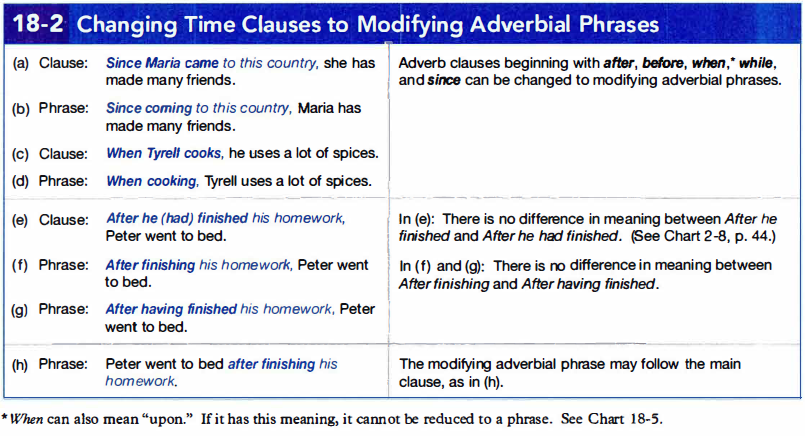
🔹 Time clauses start with words like when, while, after, before, since, until.
🔹 To reduce a time clause, remove the subject and change the verb to the -ing form.
✅ Examples:
- After he finished his homework, he went out. → After finishing his homework, he went out.
- While she was reading, she drank coffee. → While reading, she drank coffee.
- Before he left, he packed his bag. → Before leaving, he packed his bag.
📌 Key point: The subject of the adverbial phrase must be the same as the subject in the main clause.
🚫 Incorrect: While reading, the TV was on. ❌ (Who is reading?)
✅ Correct: While reading, she turned on the TV. ✔️
18c. Expressing the Idea of “During the Same Time” in Modifying Adverbial Phrases

🔹 When two actions happen at the same time, we can shorten one clause.
🔹 Use while + -ing verb or just the -ing verb.
✅ Examples:
- While she was cooking, she listened to music. → While cooking, she listened to music.
- He whistled while he walked down the street. → He whistled while walking down the street.
📌 Key point: If “while” is removed, the phrase can come before or after the main clause.
- Walking down the street, he whistled. ✔️
- He whistled, walking down the street. ✔️
🚫 Incorrect: Walking down the street, the birds were singing. ❌ (Who is walking?)
18d. Expressing Cause and Effect in Modifying Adverbial Phrases
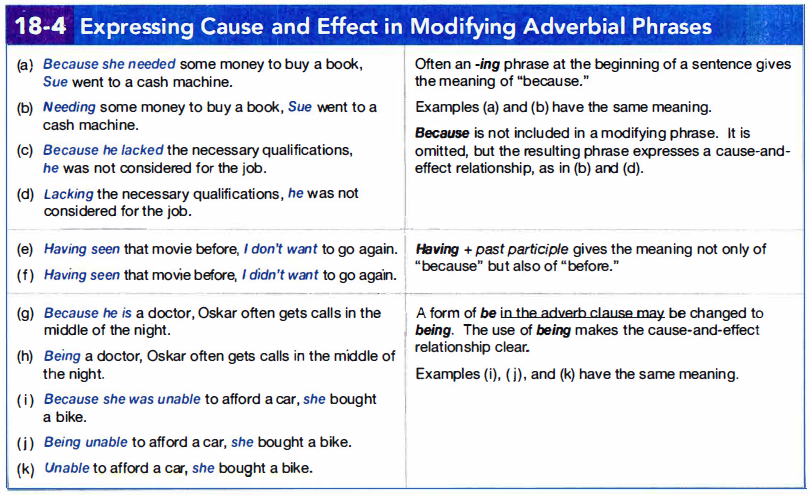
🔹 To show cause and effect, use “because, since, as” in a full adverb clause.
🔹 In the reduced form, use the -ing verb at the beginning of the sentence.
✅ Examples:
- Because she was tired, she went to bed early. → Being tired, she went to bed early.
- Since he didn’t study, he failed the test. → Not studying, he failed the test.
- As she didn’t know the answer, she stayed silent. → Not knowing the answer, she stayed silent.
📌 Key point:
- If the sentence is negative, use “Not + -ing” (e.g., Not knowing the answer).
- The cause (reason) comes first, followed by the main action.
🚫 Incorrect: Being tired, the bed looked comfortable. ❌ (The bed isn’t tired!)
18e. Using Upon + -ing in MOdifying Adverbial Phrases

🔹 “Upon + -ing” is a formal way to express “as soon as” or “after”.
🔹 Often used in formal writing and storytelling.
✅ Examples:
- Upon arriving at the airport, she called her friend. (= As soon as she arrived)
- Upon hearing the news, he rushed to the hospital. (= After he heard the news)
- Upon entering the room, she noticed the decorations.
📌 Key point:
- “Upon” means immediately after something happens.
- More formal than “after + -ing”.
🚫 Incorrect: Upon he arrived, he called her. ❌
✅ Correct: Upon arriving, he called her. ✔️
19. CONNECTIVES THAT EXPRESS CAUSE AND EFFECT, CONTRAST, AND CONDITION

Connectives are words or phrases that link ideas in a sentence, making relationships between them clear and logical. This section explores different types of connectives that express cause and effect, contrast, and condition.
What you will learn:
✅ Cause and effect can be expressed with “because of, due to, therefore, consequently, so”.
✅ “Such … that” and “so … that” emphasize strong relationships between cause and result.
✅ Purpose is expressed using “so that” + modal verbs (can, could, will, would).
✅ Contrast is shown with “although, despite, whereas, however”.
✅ Conditions are expressed using “otherwise” and “or else”.
✅ Proper punctuation (commas, semicolons) is essential for clarity.
19a. Introduction
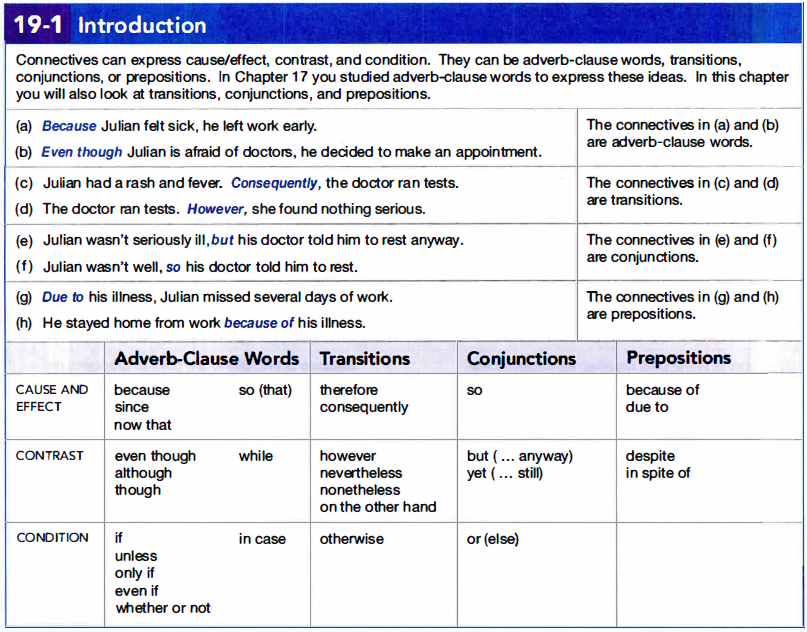
🔹 Connectives help create coherence and logical flow in writing and speech.
🔹 There are three main categories of connectives:
- Cause and Effect (e.g., because, due to, therefore, consequently)
- Contrast (e.g., however, although, but, despite)
- Condition (e.g., if, unless, otherwise, or else)
📌 Key point: The correct use of these connectives makes writing more professional and structured.
19b. Using Because Of and Due To
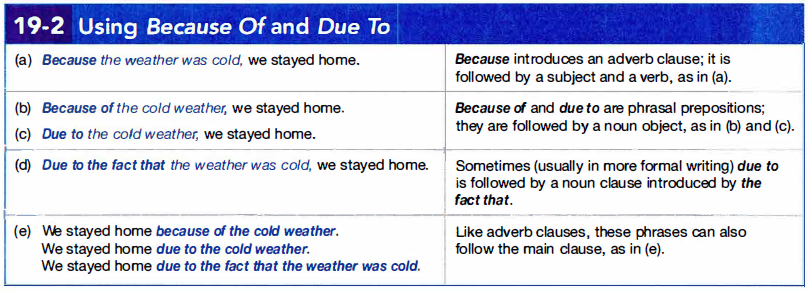
🔹 Both “because of” and “due to” show reasons or causes.
🔹 They are followed by a noun or noun phrase (not a full sentence).
✅ Examples:
- The match was canceled because of the heavy rain.
- The delay was due to a technical issue.
📌 Key Differences:
| Expression | Usage | Example |
|————|————|—————–|
| Because of | General reason | She left because of the noise. |
| Due to | More formal, often follows “to be” | The accident was due to driver error. |
🚫 Incorrect: He was late due to he missed the bus. ❌
✅ Correct: He was late because he missed the bus. ✔️
19c.Cause and Effect: Using Therefore, Consequently, and So

🔹 These words connect cause (reason) and effect (result).
🔹 They come between two independent clauses (two complete sentences).
✅ Examples:
- It was raining; therefore, the game was postponed.
- She studied hard. Consequently, she passed the exam.
- He was tired, so he went to bed early.
📌 Key Differences:
| Expression | Usage | Example |
|---|---|---|
| Therefore | Formal, logical | The road was blocked; therefore, we took a detour. |
| Consequently | Strong cause-effect | She skipped class; consequently, she failed the test. |
| So | More informal | It was cold, so I wore a jacket. |
🚫 Incorrect: It was raining, therefore the match was postponed. ❌ (Needs a semicolon or period before “therefore”)
✅ Correct: It was raining; therefore, the match was postponed. ✔️
19d. Summary of Patterns and Punctuation
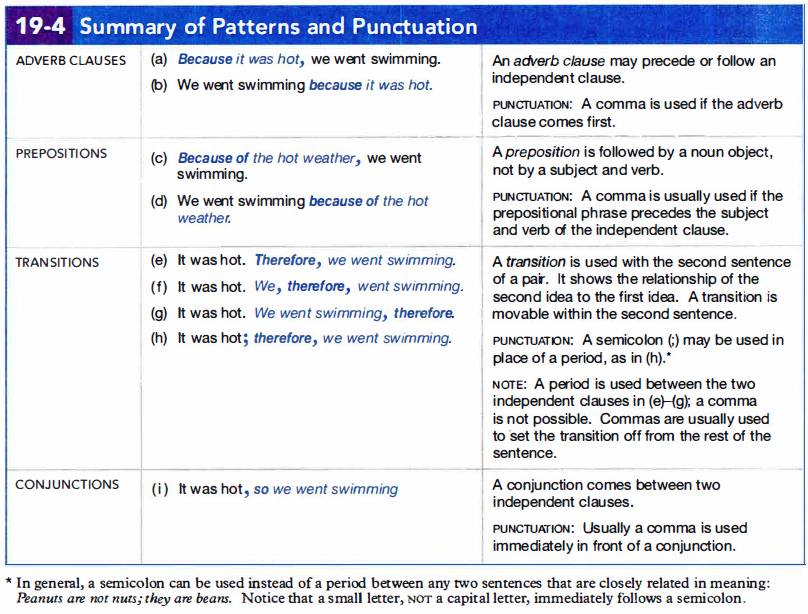
🔹 Cause-and-effect connectives follow specific patterns:
1️⃣ Cause + Effect (Reason first)
- Because of the storm, the flight was delayed.
- Due to bad weather, we stayed indoors.
2️⃣ Effect + Cause (Result first)
- The flight was delayed because of the storm.
- We stayed indoors due to bad weather.
3️⃣ Connector between two independent clauses
- It was late; therefore, we left.
- He was sick; consequently, he missed school.
📌 Key point:
- Use a comma after therefore and consequently when they appear at the beginning of a sentence.
- Use a semicolon (;) before therefore and consequently when joining two independent clauses.
19e. Other Ways of Expressing Cause and Effect: Such ... That and So ... That
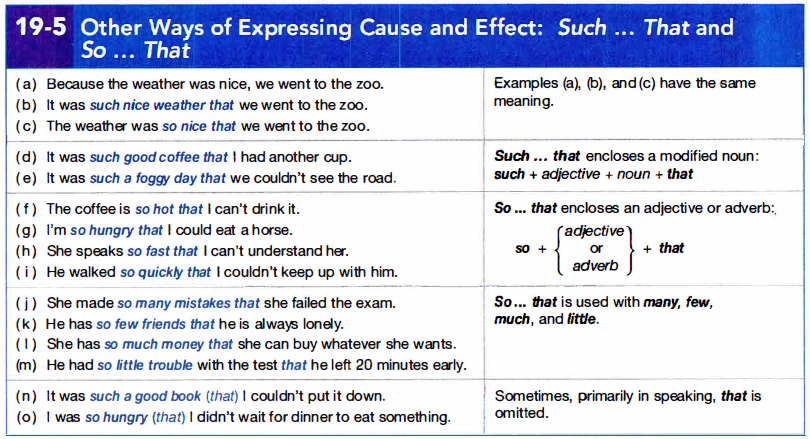
🔹 These phrases show a strong cause-effect relationship.
🔹 They describe how strong or extreme something is.
✅ Examples:
- The test was so difficult that many students failed.
- She was such a talented singer that she won the competition.
📌 Key Differences:
| Expression | Structure | Example |
|---|---|---|
| So … that | So + adjective/adverb + that | He was so tired that he fell asleep immediately. |
| Such … that | Such + noun phrase + that | It was such a hot day that we stayed inside. |
🚫 Incorrect: She was such tired that she slept. ❌
✅ Correct: She was so tired that she slept. ✔️
19f. Expressing Purpose: Using So That

🔹 “So that” shows purpose or intended result.
🔹 It is often followed by can, could, will, or would.
✅ Examples:
- She spoke slowly so that everyone could understand her.
- I left early so that I wouldn’t be late.
🚫 Incorrect: I study hard so that pass the exam. ❌
✅ Correct: I study hard so that I can pass the exam. ✔️
19g. Showing Contrast (Unexpected Result)
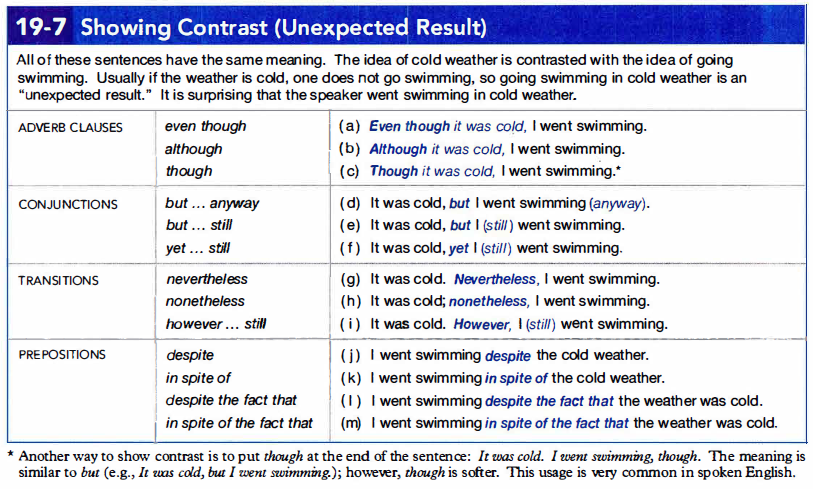
🔹 Words like although, even though, despite, in spite of show unexpected results.
🔹 Although/even though are followed by a full sentence.
🔹 Despite/in spite of are followed by a noun or gerund (-ing form).
✅ Examples:
- Although it was raining, we went out.
- Even though she was sick, she went to work.
- Despite being tired, he continued working.
- In spite of the high price, she bought the dress.
📌 Key point:
- Despite/In spite of ≠ Although/Even though (different structures)
🚫 Incorrect: Despite she was sick, she went out. ❌
✅ Correct: Despite being sick, she went out. ✔️
19h. Showing Direct Contrast
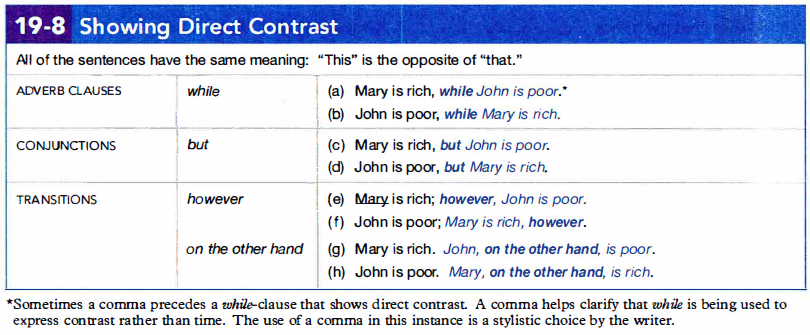
🔹 However, on the other hand, whereas, while show clear differences.
🔹 They compare opposing ideas.
✅ Examples:
- She loves coffee; however, he prefers tea.
- I like action movies, whereas my sister likes romance.
- He is outgoing, while his brother is shy.
🚫 Incorrect: She loves coffee, however he prefers tea. ❌
✅ Correct: She loves coffee; however, he prefers tea. ✔️
19i. Expressing Conditions: Using Otherwise and Or (Else)

🔹 Otherwise and or else show what will happen if a condition is not met.
🔹 Otherwise is more formal than or else.
✅ Examples:
- You must wear a seatbelt; otherwise, you could get a fine.
- Study hard, or else you will fail the test.
- Take an umbrella; otherwise, you might get wet.
🚫 Incorrect: You must study, otherwise you fail. ❌
✅ Correct: You must study; otherwise, you will fail. ✔️
20. CONDITIONAL SENTENCES AND WISHES

Conditional sentences and wish statements allow us to talk about possibilities, hypothetical situations, regrets, and desires. They use specific verb forms to express different timeframes and degrees of reality.
What you will learn:
✅ First conditional = Real possibilities (If it rains, we will stay inside.)
✅ Second conditional = Hypothetical present/future (If I were rich, I would travel.)
✅ Third conditional = Hypothetical past (If I had studied, I would have passed.)
✅ Mixed conditionals link past causes to present consequences (If I had saved money, I wouldn’t be broke now.)
✅ “Wish” statements express regrets, desires, and frustration (I wish I were taller.)
✅ “If” can be omitted in formal cases (Had I known, I would have helped.)
20a. Overview of Basic Verb Forms Used in Conditional Sentences
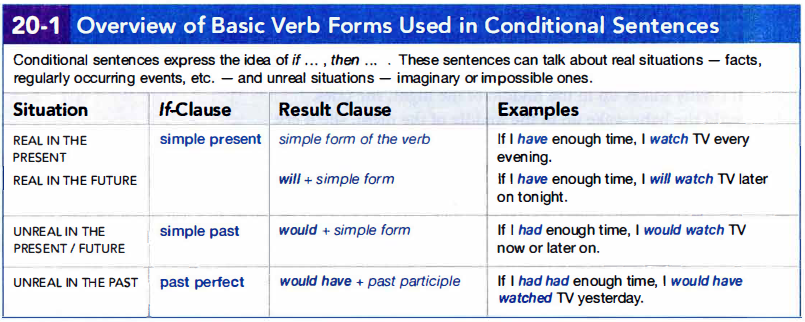
🔹 Conditional sentences usually have two parts:
- If-clause (condition) → states the situation.
- Main clause (result) → shows what happens as a consequence.
🔹 There are four main types of conditional sentences:
- Zero conditional (general facts)
- First conditional (real future possibilities)
- Second conditional (unreal/hypothetical present or future)
- Third conditional (unreal/hypothetical past)
📌 Example Structure:
- If + subject + verb (condition), subject + verb (result).
20b. Expressing Real Conditions in the Present or Future
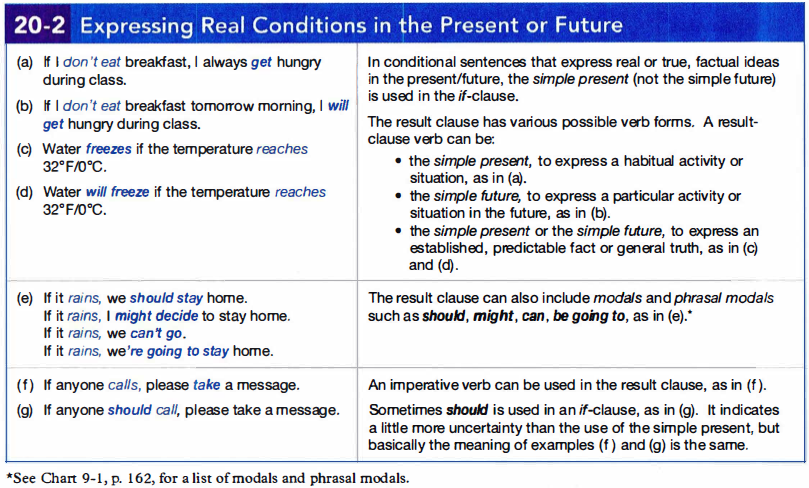
🔹 Used for likely or possible situations in the present or future.
🔹 Structure: If + present simple, will + base verb.
✅ Examples:
- If it rains, we will stay inside.
- If she studies hard, she will pass the test.
📌 Key Points:
- “Will” can be replaced with “may” or “might” to show uncertainty.
- Instead of “will,” imperatives can be used (If you’re tired, go to bed!).
🚫 Incorrect: If it will rain, we will stay inside. ❌
✅ Correct: If it rains, we will stay inside. ✔️
20c. Unreal (Contrary to Fact) in the Present or Future

🔹 Used for hypothetical or unlikely situations.
🔹 Structure: If + past simple, would + base verb.
✅ Examples:
- If I were rich, I would travel the world.
- If she had a car, she would drive to work.
📌 Key Points:
- “Were” is used instead of “was” for all subjects (If I were you, I would…).
- “Would” can be replaced with could or might (If I had a car, I could drive to work).
🚫 Incorrect: If I am rich, I would travel the world. ❌
✅ Correct: If I were rich, I would travel the world. ✔️
20d. Unreal (Contrary to Fact) in the Past

🔹 Used to express regret or hypothetical past events.
🔹 Structure: If + past perfect, would have + past participle.
✅ Examples:
- If she had studied, she would have passed the test.
- If we had left earlier, we wouldn’t have missed the train.
📌 Key Points:
- Used when talking about missed opportunities or regrets.
- Instead of “would have,” you can use could have/might have (If I had known, I could have helped you).
🚫 Incorrect: If I would have studied, I would have passed. ❌
✅ Correct: If I had studied, I would have passed. ✔️
20e. Using Progressive Verb Forms in Conditional Sentences

🔹 Used to emphasize an ongoing or temporary action.
✅ Examples:
- If she were working, she wouldn’t answer the phone. (Second Conditional)
- If he had been driving carefully, he wouldn’t have crashed. (Third Conditional)
📌 Key Points:
- Second Conditional: “Were + verb-ing” for ongoing hypothetical situations.
- Third Conditional: “Had been + verb-ing” for ongoing past conditions.
20f. Using “Mixed Time” in Conditional Sentences

🔹 Used when the if-clause and result clause refer to different timeframes.
✅ Examples:
- If I had studied harder (past), I would be a doctor now (present).
- If she had saved money (past), she wouldn’t be struggling now (present).
📌 Key Point:
- Often used to connect past actions with present consequences.
20g. Omitting If

🔹 In formal or literary English, “if” can be omitted by inverting the subject and verb.
✅ Examples:
- Had I known, I would have helped you. (= If I had known, I would have helped you.)
- Were I you, I would take the job. (= If I were you, I would take the job.)
📌 Key Point:
- “Had” / “Were” / “Should” are used at the beginning to replace “if.”
🚫 Incorrect: Was I rich, I would travel the world. ❌
✅ Correct: Were I rich, I would travel the world. ✔️
20h. Implied Conditions

🔹 Sometimes, the “if” clause is understood rather than stated.
✅ Examples:
- I wouldn’t do that in your position. (= If I were you, I wouldn’t do that.)
- One more mistake, and you’re fired! (= If you make one more mistake, you’re fired.)
📌 Key Point:
- Used in spoken English for brevity.
20i. Wishes About the Present and Past
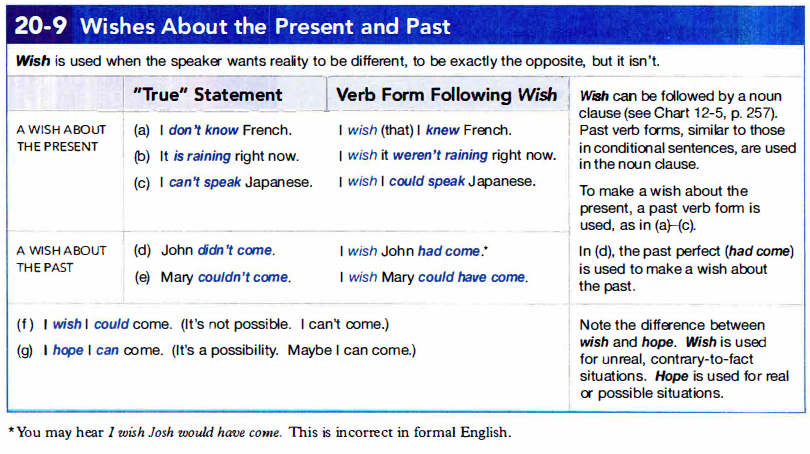
🔹 Used to express regret or desire for change.
🔹 Structure:
- Present wish → Wish + past simple (unreal present).
- Past wish → Wish + past perfect (regret about the past).
✅ Examples:
- I wish I were taller. (I am not taller, but I want to be.)
- She wishes she had studied harder. (She regrets not studying.)
📌 Key Point:
- “Were” is used instead of “was” (I wish I were a millionaire!).
20j. Wishes About the Futures; Use of Wish + Would

🔹 Used to express frustration or a desire for change in the future.
🔹 Structure: Wish + would + base verb.
✅ Examples:
- I wish it would stop raining.
- She wishes he would call her back.
📌 Key Points:
- Used to talk about things we cannot control.
- Cannot be used for our own actions (I wish I would study harder ❌).
